#albert iii of habsburg
Photo



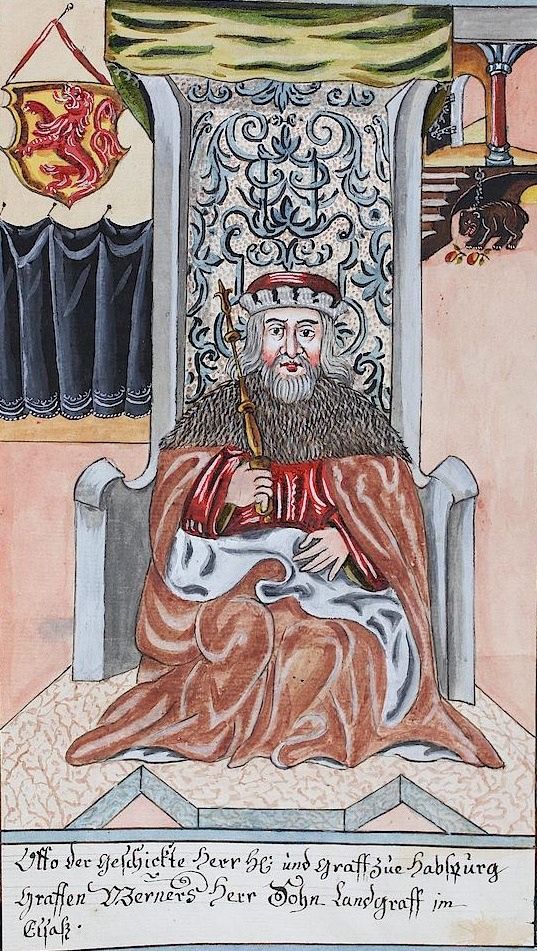


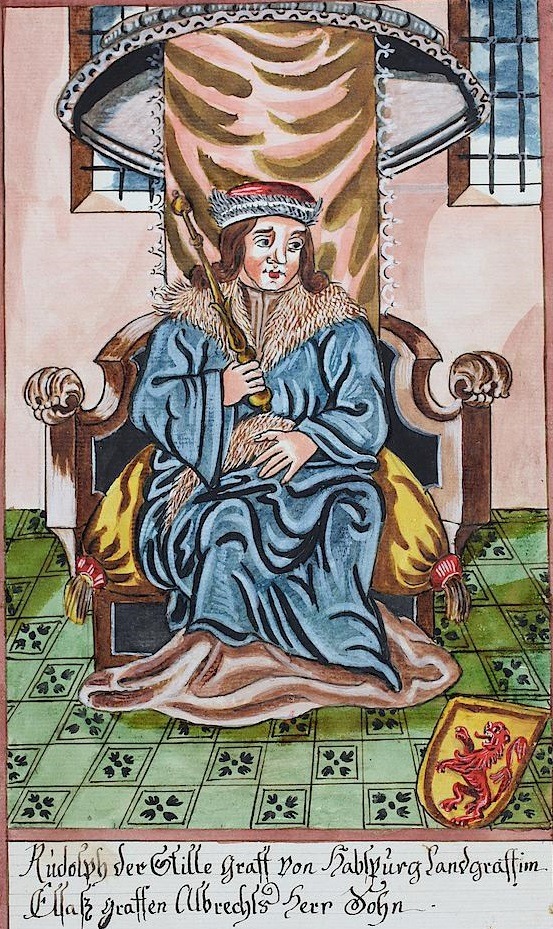
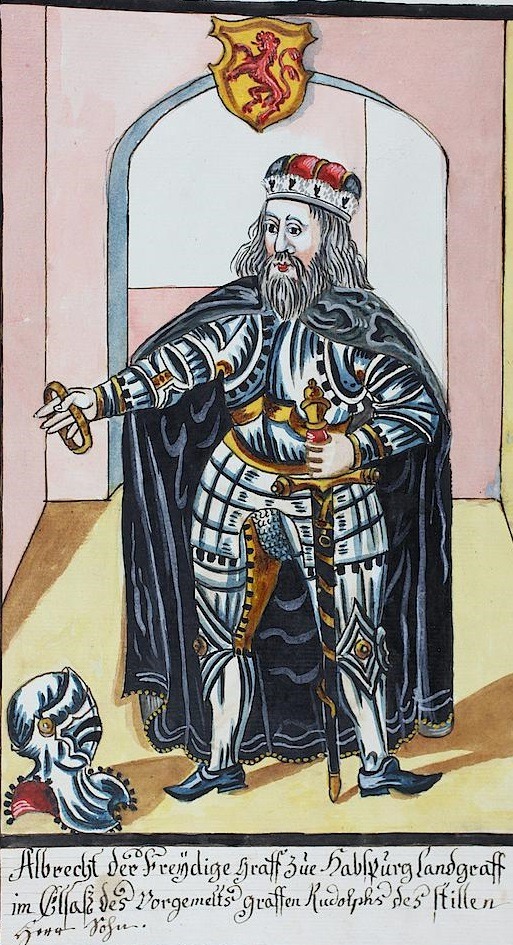
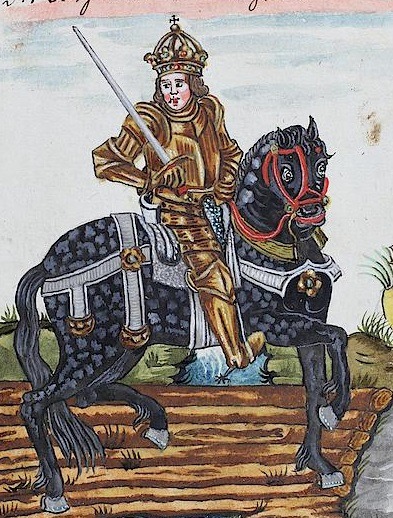
List of Monarchs: The House of Habsburg.
1. Guntram the Rich (920-973; the progenitor of the House of Habsburg and the House of Zähringen). Guntram possessed lands in Alsace and in Breisgau, from Vogesen to Kaiserstuhl and the Black Forest.
2. Radbot of Klettgau (c. 985 – 1045). He was Graf (Count) of the county of Klettgau. He built Habsburg Castle.
3. Werner I, Count of Klettgau (c. 1025/1030-1096). Sometimes called Werner the Pious. He had two sons: Otto II, and Albert II.
4. Otto II, Count of Habsburg (d. 1111). Graf (Count) of Habsburg and one of the founding members of the Habsburg family.
5. Werner II, Count of Habsburg (d.1167). He was the great-great-grandfather of King Rudolph I of Germany.
6. Albert III, Count of Habsburg (d. 1199; also known as Albert the Rich). Like his father, he was a loyal supporter of the Imperial House of Hohenstaufen.
7. Rudolf II, Count of Habsburg (Rudolph the Kind; d. 1232).
8. Albert IV, Count of Habsburg (Albert the Wise; 1188-1239). On the death of his father in 1232, he divided the family estate with his brother Rudolf III, retaining the ancestral seat of Habsburg Castle. A follower of Emperor Frederick II of Hohenstaufen, he took part in the Barons' Crusade of 1239 with King Theobald I of Navarre and died near Ashkelon.
9. Rudolf I of Germany (1218-1291).
#Chroniken der Habsburger der Zähringer und der Stadt Freiburg#german aristocracy#haus habsburg#house of habsburg#österreich#guntram the rich#rabdot of klettgau#list of monarchs#graf von habsburg#habsburg#herzogtum österreich#heiliges römisches reich#count of habsburg#House of Zähringen#Zähringer#full length portrait#werner of klettgau#otto ii of habsburg#werner ii of habsburg#albert iii of habsburg#rudolf ii of habsburg#albert iv of habsburg#in armour#full-length portrait
8 notes
·
View notes
Text
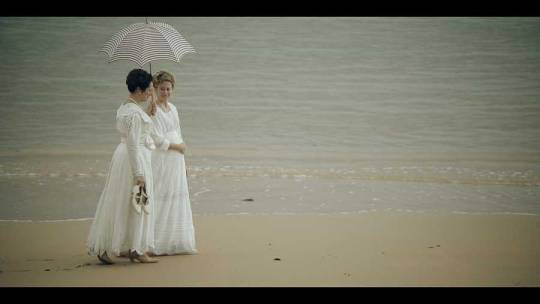
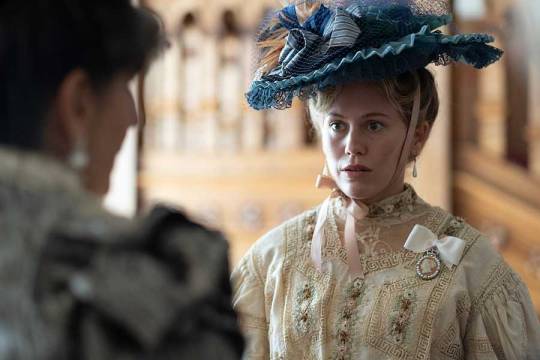


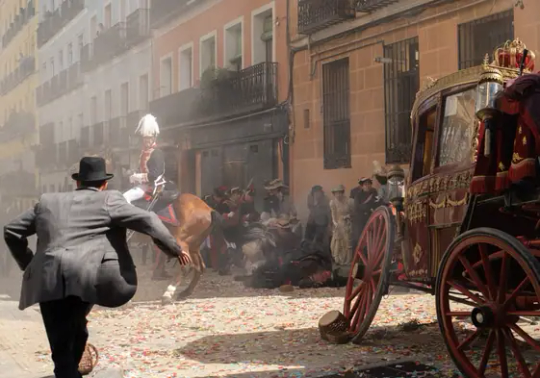



Upcoming series: Ena
In September, the filming of Ena began, a biographical series that will focus on the life of Victoria Eugenie of Battenberg, queen of Spain through her marriage to Alfonso XIII between May 31, 1906 and April 14, 1931, after being the monarchy deposed later by the proclamation of the Second Republic. Great-grandmother of the current king Philip VI of Spain, of whom she was godmother at his baptism. Throughout six chapters, the series will tell the life of Victoria Eugenie and at the same time offer a portrait of a time that changed the world, the first half of the 20th century, from 1905 to 1945. Born on October 24, 1887 in Aberdeenshire, Scotland, Ena was the daughter of Henry of Battenberg and Princess Beatrice, youngest daughter of Queen Victoria of the United Kingdom and Prince Albert of Saxe-Coburg and Gotha. Her godmother was Eugenia de Montijo, empress consort of France as Napoleón III's wife. The name of the series comes from what her friends and family called her since she was little, Ena.
The fiction is based on the novel of the same name by Pilar Eyre. Javier Olivares, who was behind the acclaimed Isabel and El Ministerio del Tiempo, will be the showrunner and plot manager for Ena. In addition to Olivares, the script is written by Isa Sánchez, Daniel Corpas and Pablo Lara Toledo. The series will be directed entirely by women: Anaïs Pareto, director of the series as a whole, in addition to four episodes, and Estel Díaz, who will direct two episodes.
“Ena is the portrait of historical moments that seem distant but are not so far away, because without them we would not understand the times we live in now,” Olivares declares in the press release sent by TVE. The writer and screenwriter remembers that Victoria Eugenie “fought to be happy in a bitter time, in which she witnessed two world wars, a civil war and a great pandemic, the tortuously called Spanish flu.”
For Pilar Eyre, author of the novel, she was "an extraordinary woman: cultured, supportive, liberal-minded, modern and very loyal." And she is excited because "finally all Spaniards can know" the story of a "misunderstood" woman. in their time, which they will always consider foreign." It is a fiction co-produced by RTVE with Ena La Serie AIE, La Cometa TV and Zona App. José Pastor, director of Film and Fiction at RTVE, has pointed out that "it is a "RTVE is proud to be able to portray this interesting historical character, from the point of view of two women directors and with Javier Olivares as showrunner, in one of its best series."
The Spanish actress of Anglo-Danish descent Kimberly Tell will play Ena and Joan Amargós will play Alfonso XIII. For her part, Elvira Mínguez will play Maria Christina von Habsburg-Lothringen, mother of Alfonso XIII. The cast is completed by Lucía Guerrero (Beatrice of Saxe-Coburg and Gotha), Raúl Mérida (Alfonso of Orleans and Bourbon), Juan Gea (Álvaro Figueroa y Torres, Count of Romanones), María Morales (María del Carmen Angoloti y Mesa, Duchess of Victoria), Pedro Mari Sánchez (Rodrigo de Saavedra y Vinent, Marquis of Villalobar), Luisa Gavasa (Eugenia de Montijo) and Joaquín Notario (José de Saavedra y Salamanca, Marquis of Viana)
Mariano Peña will play Miguel Primo de Rivera; Jaume Madaula will play the anarchist Mateo Morral, author of the attack committed at the royal wedding; Tomás del Estal will be Emilio María de Torres y González-Arnáu, and Ángel Ruiz will once again give life to Federico García Lorca, a character he already played in El Ministerio del Tiempo, among others.
The series will be filmed entirely in natural exteriors and interiors, like the Royal Palace of Madrid, the Palace of La Granja de San Ildefonso (Segovia), the Palace of Santoña (Madrid), the Palace of Fernán Núñez (Madrid), the Fort of San Francisco (Guadalajara) and the Magdalena Palace (Santander), built in 1911 by the City Council as a tribute to the monarchs and where Ena spent a good part of her summers in Spain, accompanied by the Royal Family. Filming for the series will continue until the end of December.
~~~~~~~~~~~~~~~~~~~~~~~~~~~~~~~~~~~~~~~~~~
So, the Magdalena Palace is going to be an important location during the series as a summer palace, the main filming location in Gran Hotel, and in that series Ena appeared in the episode 3×13, played by Aída Filx.
Apart from that, are we getting an Olivaresverse (XD)? Most likely not, and it's just references about his previous works as a showrunner, but there are connections between Isabel, Emdt and Ena: Michelle Jenner starring Isabel as Isabella I of Castile, then appearing in a couple of scenes in Emdt episode 1×04 and being an important figure in the lore as the foundress of the ministry (& Eusebio Poncela playing as Cisneros in both series, and also he played Cisneros in the film La Corona Partida and the Carlos Rey Emperador series); Alfonso XIII is a descendant of Isabella I of Castile; Ángel Ruiz appeard as Lorca in Emdt in 4 episodes and now he is on Ena playing as Lorca again, we don't know yet how much screentime he will get or which will his role be (secondary character most likely), but it's great to see more about him!
#Ena#period dramas#upcoming series#ena tve#victoria eugenie of battenberg#maria christina von hasburg#alfonso xiii of spain#kimberley tell#joan amargós#rtve series#pilar eyre#javier olivares#anaïs pareto#estel diaz#federico garcía lorca#ángel ruiz#elvira míngez#maria christina von hasburg-lothringen#lucía guerrero#beatrice of saxe-coburg and gotha#raúl mérida#alfonso of orleans and bourbon#juan gea#álvaro figueroa y torres#maría morales#maría del carmen angoloti y mesa#pedro mari sánchez#rodrigo de saavedra y vinent#luisa gavasa#eugenia de montijo
19 notes
·
View notes
Text
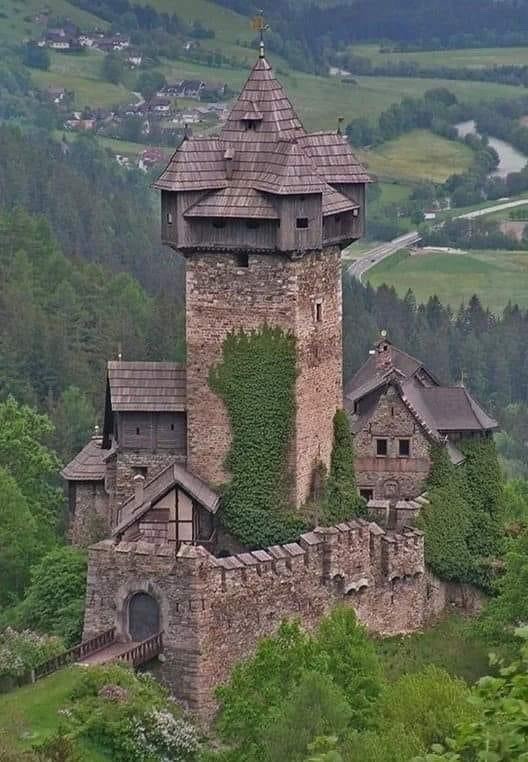
🇦🇹 Niederfalkenstein Castle is a medieval castle near Obervellach in Carinthia, Austria. It is part of the larger Falkenstein fortification complex; while the main fortress of Oberfalkenstein today is a ruin, the lower barbican of Niederfalkenstein is largely preserved.
Location
The fortification was erected on a rocky promontory on the southwestern slopes of the Reisseck Group in the Hohe Tauern mountain range, overlooking the Möll valley east of Obervellach. Niederfalkenstein is 843 metres (2,766 ft) above sea level.
The Tauern Railway line, opened in 1909, initially passed under the rock in a 67-metre (220 ft) long tunnel. In the course of the double-tracked expansion carried out from 1971 to 1973, the rail tunnel was replaced by a wide arch bridge, the present-day Falkenstein Bridge passing between Ober- and Niederfalkenstein, with 396 metres (1,299 ft) the longest of the line and one of the longest in Austria.
The ruins of Oberfalkenstein comprise a Bergfried keep with surrounding moats and the foundations of a Romanesque palas. A chapel dedicated to John the Baptist was first mentioned in 1246, significantly enlarged in a Baroque style in 1772 and is still in use.
History
Niederfalkenstein
Niederfalkenstein Castle
The fortification was first mentioned as Valchenstain Castle in an 1164 deed. The name may be derived from Proto-Germanic walhaz (foreigner, stranger; Romance/Celtic-speaker) in terms of a Romance (Italian) settlement, referring to descendants of the former Roman city of Teurnia, who had migrated to the remote valley during the Slavic settlement of the Eastern Alps about 600.
The first documented ministerialis Gumpoldus de Valchenstein was a liensmen of Count Engelbert II of Gorizia (Görz), scion of the Meinhardiner dynasty. The Counts of Gorizia also held the office of a Vogt of the Benedictine Millstatt Abbey, and the Lord of Falkenstein established close ties to the monastery.
The Falkenstein dynasty became extinct about 1300, soon after two castles, 'Upper' and 'Lower' Falkenstein were mentioned, enfeoffed by the Counts of Gorizia to several local nobles. On 24 June 1394 Count Henry VI gave the upper castle in pawn to the Habsburg duke Albert III of Austria. It was finally seized by Albert's nephew Emperor Frederick III in 1460, after he had defeated Count John II of Gorizia in the conflict over the heritage of the extinct Counts of Celje. The lower castle was temporarily held by the Carinthian knight Andreas von Graben, who sold it in 1462.
In 1504 Frederick's son and successor Emperor Maximilian I again pawned the castle to Count Julian of Lodron, by his wife Apollonia brother-in-law of the Salzburg archbishop Matthäus Lang von Wellenburg. It was acquired by Apollonia's second husband Christoph Frankopan after Lodron's death in 1510. The countess donated an altarpiece by Jan van Scorel in the Obervellach parish church, depicting Saint Christopher, herself and her castle. At the same time, large funds had to be raised in order to restore the dilapidated premises. Afterwards, several nobles held the castle, among them the descendants of Gabriel von Salamanca-Ortenburg and the Khevenhüller dynasty, while the premises decayed. When the Austrian mountaineer Joseph Kyselak visited the site in 1825, it largely laid in ruins.
Rebuilt from 1905, the Unterfalkenstein palas burnt down after a burglary in 1969 and had to be restored again. Up to today the castle is a private property, but can be visited in summer. 👉👉👉👉 Du kilt à la Harpe , errance celtique — em Falkenstein Castle (Niederfalkenstein)
3 notes
·
View notes
Text
Hunting after the war
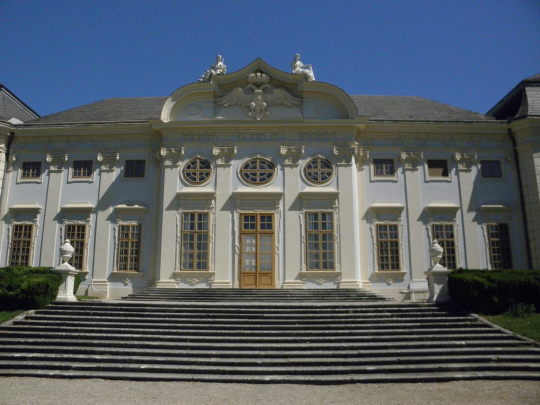
When the architect Johann Lukas von Hildebrandt began planning the construction of Schloß Halbturn in 1701, it was only a hunting lodge and Austria was still under the rule of Emperor Joseph I. Located on the borderlands between the Austrian and Hungarian possessions, it was only a short distance from Lake Neusiedl.
When the original construction was completed in 1711, a new emperor assumed the highest office in the Holy Roman-Germanic Empire, Karl VI, who ended his Spanish adventure by attempting to become the effective king of Spain under the name of Charles III. Halbturn was to become his hunting lodge for the new times that awaited him.
However, the documented existence of Halbturn dates back at least to the 15th century, when the Counts of Bazin (Bösing, in German, the present-day Slovak town of Pezinok) disputed the boundaries of their possessions with the abbey of Heiligenkreuz. On that occasion, the Hungarian king Mátyás Hunyadi, better known as Matthias Corvinus, was asked to act as arbitrator, and the abbey benefited from property and vineyards.
The area around Halbturn was present in Roman times, documented by a cemetery from the Imperial period and a Roman villa. A Jewish community is believed to have existed as early as the 3rd century.
The name Halbturn is identified with a half-ruined tower or damaged fortification. Its origin may have served to protect the road from Neusiedl to Altenburg (the modern Hungarian town of Mosonmagyaróvár) and from Ödenburg (Sopron in Hungarian) to Preßburg (the German name for the present-day Slovak capital, Bratislava).
In 1516, the Bazin family died out and their possessions reverted to the crown. The then king Lajos II of Hungary and Bohemia (under the name Ludvík I) bequeathed the estate to his wife Maria, sister of the Austrian Archduke Ferdinand I, who took over after her husband's death at the hands of the Turks at the battle of Mohács (1526).
When Queen Maria died in 1558, the possession of Halbturn passed to the Austrian Habsburgs, who already held the Imperial, Bohemian, Croatian and Hungarian crowns.
But let us return to the 18th century. During the reign of Karl VI's daughter Maria Theresia, Halbturn was rebuilt under the direction of the architect Franz Anton Hillebrandt as the summer residence of the regents of Hungary, Archduchess Maria Christina and her husband, Albert of Saxony-Teschen.
In the 19th century, the usual name was the Hungarian Féltorony, an evolution of Felthorom, documented in the 15th century, until after World War I most of the territory surrounding Lake Neusiedl became the present-day federal state of Burgenland, which was incorporated into the Republic of Austria in 1921.
2 notes
·
View notes
Text
Events 7.2
437 – Emperor Valentinian III begins his reign over the Western Roman Empire. His mother Galla Placidia ends her regency, but continues to exercise political influence at the court in Rome.
626 – Li Shimin, the future Emperor Taizong of Tang, ambushes and kills his rival brothers Li Yuanji and Li Jiancheng in the Xuanwu Gate Incident.
706 – In China, Emperor Zhongzong of Tang inters the bodies of relatives in the Qianling Mausoleum, located on Mount Liang outside Chang'an.
866 – Battle of Brissarthe: The Franks led by Robert the Strong are defeated by a joint Breton-Viking army.
936 – King Henry the Fowler dies in his royal palace in Memleben. He is succeeded by his son Otto I, who becomes the ruler of East Francia.
963 – The Byzantine army proclaims Nikephoros II Phokas Emperor of the Romans on the plains outside Cappadocian Caesarea.
1298 – The Battle of Göllheim is fought between Albert I of Habsburg and Adolf of Nassau-Weilburg.
1494 – The Treaty of Tordesillas is ratified by Spain.
1504 – Bogdan III the One-Eyed becomes Voivode of Moldavia.
1555 – Ottoman Admiral Turgut Reis sacks the Italian city of Paola.
1561 – Menas, emperor of Ethiopia, defeats a revolt in Emfraz.
1582 – Battle of Yamazaki: Toyotomi Hideyoshi defeats Akechi Mitsuhide.
1613 – The first English expedition (from Virginia) against Acadia led by Samuel Argall takes place.
1644 – English Civil War: Battle of Marston Moor.
1645 – Battle of Alford: Wars of the Three Kingdoms.
1698 – Thomas Savery patents the first steam engine.
1723 – Bach's Magnificat is first performed.
1776 – American Revolution: The Continental Congress adopts a resolution severing ties with the Kingdom of Great Britain although the wording of the formal Declaration of Independence is not adopted until July 4.
1816 – The French frigate Méduse strikes the Bank of Arguin and 151 people on board have to be evacuated on an improvised raft, a case immortalised by Géricault's painting The Raft of the Medusa.
1822 – Thirty-five slaves, including Denmark Vesey, are hanged in South Carolina after being accused of organizing a slave rebellion.
1823 – Bahia Independence Day: The end of Portuguese rule in Brazil, with the final defeat of the Portuguese crown loyalists in the province of Bahia.
1839 – Twenty miles off the coast of Cuba, 53 kidnapped Africans led by Joseph Cinqué mutiny and take over the slave ship Amistad.
1840 – A Ms 7.4 earthquake strikes present-day Turkey and Armenia; combined with the effects of an eruption on Mount Ararat, kills 10,000 people.
1853 – The Russian Army crosses the Prut river into the Danubian Principalities (Moldavia and Wallachia), providing the spark that will set off the Crimean War.
1864 – Dimitri Atanasescu founds the first Romanian school in the Balkans for the Aromanians in Trnovo, in the Ottoman Empire (now in North Macedonia).
1871 – Victor Emmanuel II of Italy enters Rome after having conquered it from the Papal States.
1881 – Charles J. Guiteau shoots and fatally wounds U.S. President James A. Garfield (who will die of complications from his wounds on September 19).
1890 – The U.S. Congress passes the Sherman Antitrust Act.
1897 – British-Italian engineer Guglielmo Marconi obtains a patent for radio in London.
1900 – An airship designed and constructed by Count Ferdinand von Zeppelin of Germany made its first flight on Lake Constance near Friedrichshafen.
1900 – Jean Sibelius' Finlandia receives its première performance in Helsinki with the Helsinki Philharmonic Society conducted by Robert Kajanus.
1921 – World War I: U.S. President Warren G. Harding signs the Knox–Porter Resolution formally ending the war between the United States and Germany.
1934 – The Night of the Long Knives ends with the death of Ernst Röhm.
1937 – Amelia Earhart and navigator Fred Noonan are last heard from over the Pacific Ocean while attempting to make the first equatorial round-the-world flight.
1940 – Indian independence leader Subhas Chandra Bose is arrested and detained in Calcutta.
1940 – The SS Arandora Star is sunk by U-47 in the North Atlantic with the loss of over 800 lives, mostly civilians.
1962 – The first Walmart store, then known as Wal-Mart, opens for business in Rogers, Arkansas.
1964 – Civil rights movement: U.S. President Lyndon B. Johnson signs the Civil Rights Act of 1964 meant to prohibit segregation in public places.
1966 – France conducts its first nuclear weapon test in the Pacific, on Moruroa Atoll.
1976 – End of South Vietnam; Communist North Vietnam annexes the former South Vietnam to form the unified Socialist Republic of Vietnam.
1986 – Rodrigo Rojas and Carmen Gloria Quintana are burnt alive during a street demonstration against the dictatorship of General Augusto Pinochet in Chile.
1986 – Aeroflot Flight 2306 crashes while attempting an emergency landing at Syktyvkar Airport in Syktyvkar, in present-day Komi Republic, Russia, killing 54 people.
1988 – Marcel Lefebvre and the four bishops he consecrated were excommunicated by the Holy See.
1990 – In the 1990 Mecca tunnel tragedy, 1,400 Muslim pilgrims are suffocated to death and trampled upon in a pedestrian tunnel leading to the holy city of Mecca.
1994 – USAir Flight 1016 crashes near Charlotte Douglas International Airport, killing 37 of the 57 people on board.
1997 – The Bank of Thailand floats the baht, triggering the Asian financial crisis.
2000 – Vicente Fox Quesada is elected the first President of México from an opposition party, the Partido Acción Nacional, after more than 70 years of continuous rule by the Partido Revolucionario Institucional.
2001 – The AbioCor self-contained artificial heart is first implanted.
2002 – Steve Fossett becomes the first person to fly solo around the world nonstop in a balloon.
2005 – The Live 8 benefit concerts takes place in the G8 states and in South Africa. More than 1,000 musicians perform and are broadcast on 182 television networks and 2,000 radio networks.
2008 – Colombian conflict: Íngrid Betancourt, a member of the Chamber of Representatives of Colombia, is released from captivity after being held for six and a half years by FARC.
2010 – The South Kivu tank truck explosion in the Democratic Republic of the Congo kills at least 230 people.
2013 – The International Astronomical Union names Pluto's fourth and fifth moons, Kerberos and Styx.
2013 – A magnitude 6.1 earthquake strikes Aceh, Indonesia, killing at least 42 people and injuring 420 others.
0 notes
Text
Schloß Halbturn
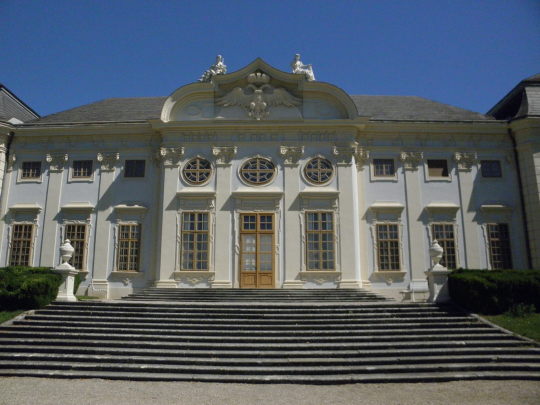
Quan el 1701 l’arquitecte Johann Lukas von Hildebrandt va començar a planificar la construcció del palau de Halbturn, només es tractava d’un pavelló de caça i Àustria restava encara sota el ceptre de l’emperador Joseph I. Situat a terres frontereres entre les possessions austriaques i hongareses, es trobava a poca distància del llac de Neusiedl.
En acabar la construcció original, el 1711, un nou emperador assumiria el més alt càrrec del Sacre Imperi Romano-Germànic, Karl VI, que tot just acabava així la seva aventura espanyola intentant convertir-se en rei efectiu d’Espanya sota el nom de Carles III. Halbturn es convertiria en el seu pavelló de caça per als nous temps que l’esperaven.
No obstant, l’existència documentada de Halbturn es remunta almenys fins al segle XV, quan els comtes de Bazin (Bösing, en alemany, l’actual ciutat eslovaca de Pezinok) disputaren amb l’abadia de Heiligenkreuz els límits de les seves possessions. En aquella ocasió, al rei d’Hongria Mátyás Hunyadi, més conegut com Maties Corví, se li va demanar que exercís com a àrbitre i l’abadia va sortir beneficiada amb propietats i vinyes.
A la zona que envolta Halbturn hi va haver presència a l’època romana, documentada per un cementiri de l’època imperial i una vil·la romana. I es creu que al segle III ja hi havia una comunitat jueva.
El nom de Halbturn és identificat amb una torre semiderruïda o amb una fortificació malmesa. El seu origen podria haver servit per protegir el camí de Neusiedl a Altenburg (la moderna ciutat hongaresa de Mosonmagyaróvár) i d’Ödenburg (Sopron, en hongarès) a Preßburg (el nom alemany de l’actual capital eslovaca, Bratislava).
El 1516, la família comtal de Bazin es va extingir i les seves possessions van revertir a la corona. El llavors rei Lajos II d’Hongria i Bohèmia (sota el nom de Ludvík I) va llegar la finca a la seva esposa Maria, germana de l’arxiduc austriac Ferdinand I, que se’n va fer càrrec després de la mort del seu marit a mans dels turcs a la batalla de Mohács (1526).
Quan la reina Maria va morir, el 1558, la possessió de Halbturn va passar als Habsburg austriacs, que ja posseïen les corones imperial, de Bohèmia, Croàcia i Hongria.
Però tornem al segle XVIII. Durant el regnat de la filla de Karl VI, Maria Theresia, Halbturn va ser reconstruït sota la direcció de l’arquitecte Franz Anton Hillebrandt com a residència d’estiu dels regents d’Hongria, l'arxiduquessa Maria Cristina i el seu marit, Albert de Saxònia-Teschen.
Al segle XIX, el nom usual va ser l’hongarès Féltorony, evolució de Felthorom, documentat al segle XV, fins que després de la I Guerra Mundial la major part del territori que envolta el llac de Neusiedl constituí l’actual estat federat de Burgenland, incorporat a la República d’Àustria el 1921.
1 note
·
View note
Text
FRIEDRICH III
Holy Roman Emperor
A brief History... until his reunification of Habsburg Austria...
(born 1415 - died 1493)

pictured above is a portrait of the Holy Roman Emperor, by Hans Burgkmair (the Elder) from c. late 15th-early 16th century
-------------------- ~ -------------------- ~ --------------------
SERIES - On this day September Edition: Friedrich was born on 21 September 1415.
-------------------- ~ -------------------- ~ --------------------
FRIEDRICH was born on 21 September 1415, at Innsbruck in the County of Tyrol. He was the eldest son of Ernst I, Duke of Inner Austria and Cymbarka of Masovia.
He was born a member of the Leopoldian line of the HOUSE OF HABSBURG. This line had been founded following the division of the territories of the Duchy of Austria through the Treaty of Neuberg in 1379. On this occasion, two Habsburg lines were founded: the Albertinians (after his great-uncle Albrecht III, who became Duke of Austria) and the Leopoldians (after his grandfather Leopold III, who became Duke of Inner and Further Austria).
The Leopoldians in turn divided their own territories. By 1406 his father received Inner Austria (comprised of the Duchies of Styria, Carinthia and Carniola and his uncle became Friedrich IV, Duke of Further Austria (comprised of parts of Swabia, Alsace and Austria) and Count of Tyrol.
His father died in 1424 and he and his brother inherited Inner Austria sharing the title of Duke, under the Regency of their uncle. He became known as FRIEDRICH V, DUKE OF INNER AUSTRIA and his brother as Albrecht VI, also Duke of Inner Austria.
When they reached the age to rule on their own their uncle did not allow them. Only in 1435 a distant Albertinian cousin Albrecht V, Duke of Austria released them from the Regency.
Around 1439 his ambitions grew, as in June his uncle died and he became Regent to his cousin Sigismund, Duke of Further Austria and by October his cousin the Duke of Austria (who was also Albrecht II, King of the Romans; Albrecht, King of Bohemia; and Albert, King of Hungary and Croatia) also died, leaving no male heirs but a pregnant wife.
At early 1440 he was also elected as KING OF THE ROMANS and became Regent for his cousin's posthumous son Ladislaus, Duke of Austria (who later became László V, King of Hungary and Ladislav, King of Bohemia).
Days before his coronation as FRIEDRICH III, HOLY ROMAN EMPEROR in 1452, he married LEONOR, and Infanta of Portugal. She was one of the daughters of Duarte, King of Portugal and Infanta Leonor of Aragón. They had five children (check the list below), but only two survived into adulthood.
By 1453 the Duchy of Inner Austria was raised to Archduchy, so he became the ARCHDUKE OF INNER AUSTRIA, jointly with his brother.
And over the next years he succeeded in unifying again all Habsburg territories under his rule, as the Albertinian line became extinct with the death of Duke Ladislaus (the Posthumous) in 1457, and the whole of Inner Austria was left to him after his brother's death in 1463.
-------------------- ~ -------------------- ~ --------------------
Check my posts on FRIEDRICH III's children and their Royal Weddings!
FRIEDRICH III and his wife LEONOR had five children...
Christoph of Austria - died aged four months;
Maximilian I, Holy Roman Emperor - husband first of Marie (the Rich) of Burgundy, Duchess of Brabant, second of Anna, Duchess of Brittany and third of Bianca Maria Sforza;
Helene of Austria - died aged three months;
Kunigunde of Austria - wife of Albrecht IV, Duke of Bavaria; and
Johann of Austria - died aged six months.
#frederick iii#emperor frederick iii#holy roman emperor#holy roman empire#house of habsburg#habsburg#austrian royals#german royals#royals#royalty#monarchies#monarchy#royal history#austrian history#german history#european history#world history#history#albert ii#king ladislaus#history lover#15th century#history with laura
8 notes
·
View notes
Photo

This ornate backgammon board consists of two sides, each 56 centimeters square, made of delicately carved woods of disparate types expertly fitted together. The two sides are connected by bronze hinges. The Kunsthistorisches Museum lists the wood types used in the construction of this piece as oak, nut wood, rosewood, palisander, and mahogany.
While oak is native to Europe, and the listed nut wood may be from any number of nut bearing trees, the remaining three wood types all represent the substantial cost that went into the production of this board. Most rosewoods grow natively in India and Southeast Asia, palisander is also known as “Brazilian” or “Bolivian Rosewood” and only grows naturally in the Americas, as does mahogany. The expense involved in shipping these woods across the world in the year 1537, a date of production inscribed onto the board, would have been immense, and speaks to the tremendous wealth and power of whoever commissioned the crafting of this board.
The names of three craftsmen are associated with this piece. The design and concept were drawn up by Georg Hörmann, and a draft done by Jörg Breu, a craftsman active in Augsburg, however the final product is signed by Hans Kelz of Kaufbeuren. It is possible that Breu had intended to complete the entire work himself, however he died in 1537, the year the piece was produced, so Kelz may have been given the commission after Breu’s passing.
The decoration on the board is ornate. Each of the triangular sections on the interior is inlaid with a different colored wood carved in a floral shape. The interior borders are covered in elegant scenes depicting exotic animals of all sorts, from peacocks and partridges to lions, boars, and stags. At each corner, and at the half-way point of each side, a small circle contains a delicately carved scene from classical mythology.
The exterior is equally remarkable. On each side four cameos surround a central armored figure mounted on a horse. On one side the central mounted figure is Holy Roman Emperor Charles V, the ruling emperor when this board was created. Surrounding him are four of his predecessors, all ruling men of house Hapsburg. In the upper left is the armored figure of Albert II. In the upper right is Emperor Fredrick III, cousin/successor to Albert II and predecessor/father to Maximilian I. Frederick II was also Charles V’s great grandfather. Charles’s grandfather and predecessor, Emperor Maximilian I, occupies the bottom left, and Charles’s father King Philip I of Castile sits in the bottom right.
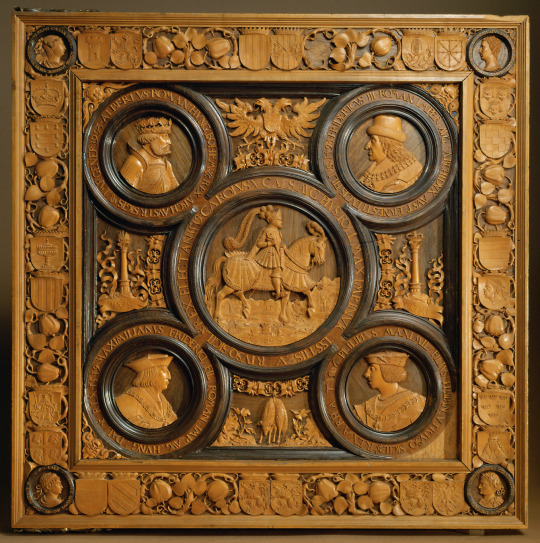
Both Maximilian and Philip are depicted wearing collars of the Order of the Golden Fleece, a prestigious knightly order founded by Duke Philip the Good of Burgundy, predecessor to Charles the Bold. The same collar encircles Charles V’s cameo. Flanking Charles are the twin pillars which support the arms of Spain, beneath them the Latin motto of the Spanish crown “Plus Ultra.” The Imperial eagle bearing the arms of the Holy Roman Emperor crowns the image.
Nestled amongst the fruits and leaves of the floral pattern on the outer edge, six coats of arms decorate each edge. These arms represent the royal claims of the Habsburg line. At each corner sits another small cameo of a classical figure; in the top left, Julius Caesar; in the top right, Augustus; in the bottom left Trajan; and in the bottom right, the Emperor Constantine.

The reverse side is decorated in much the same way. The central figure is identified as Ferdinand I, Charles V’s younger brother, who was elected King of the Romans in 1531. Surrounding him (in the same order as the previous side) are King Ferdinand V of Castille and Leon, Philip’s predecessor; the famous Charles the Bold, duke of Burgundy and great grandfather to both Charles V and Ferdinand I; King Vladisvlav II of Hungary, Croatia, and Bohemia; and finally Vladislav’s son and successor, Louis II who Ferdinand I succeeded as King of Hungary, Croatia, and Bohemia in 1526.
Charles the Bold is also shown wearing the collar of the golden fleece, and once again the collar encircles Ferdinand I, who is crowned by the Imperial eagle. Rather than being flanked by the Spanish pillars however, Ferdinand is flanked by an FA monogram, Ferdinandus Anna, representing Ferdinand and his wife Anne. Also like the previous side, the outer border of this side is decorated with flowing floral motifs set with the arms of the Habsburg dynasty as well as four cameos of classical figures. These figures are Ninus, the mythical King of Assyria; Cyrus the Great of Persia; Alexander the Great of Macedon; and Romulus, mythical founder of Rome. Each of the surviving game pieces portrays a different scene from classical mythology.
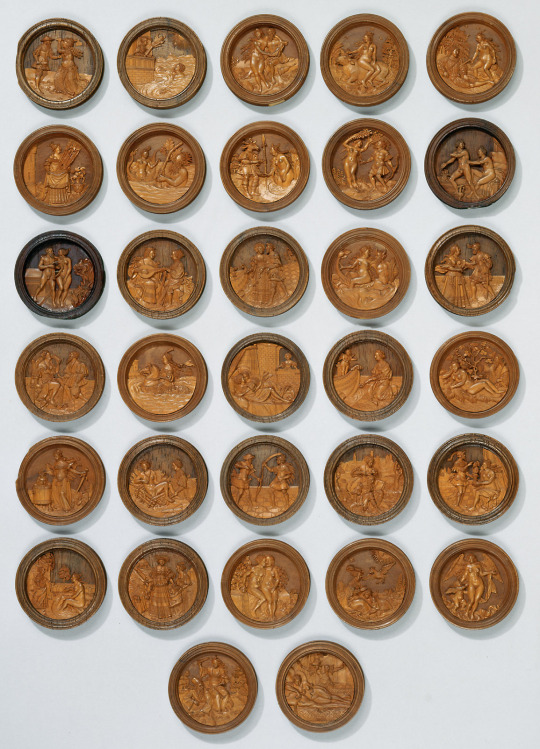
This entire piece speaks to power, not only the presence of it, but also an almost desperate attempt to legitimize it. The message is clear; the two brothers, rulers of the Holy Roman Empire sit as the centerpieces, surrounded by famous predecessors, bearers of the titles they now hold. They are wreathed in the collar of a prestigious knightly order, one that had existed for over 100 years when this board was created. The arms of their lands surround them, and the kings and emperors of old watch over them, drawing a direct line between the Roman Empire Charles ruled and the Roman Empire Julius Caesar founded. The presence of expensive woods imported from opposite ends of the world speaks to the global nature of Habsburg power. This backgammon board serves as a reminder of the immense power held by the Habsburg monarchs, the legitimacy of that power, and of how they acquired it.
One thing that cannot be said for certain about this board is who it was made for. Though the expensive woods used in its productions speak to a great degree of wealth, and the motifs suggest some connection to the court of the Holy Roman Empire, no records have yet been uncovered which can answer this question for certain. Based on the decorations which cover the exterior of the board however, I would suggest that it was made either for Ferdinand I or the Emperor himself, Charles V.
#gaming#backgammon#historical gaming#art#history#europe#european#germany#german#hre#holy roman empire#renaissance
229 notes
·
View notes
Text
Let’s talk Shop: Vlad’s Anger Pt. 3
(Part 2)
Matthias was his last hope and his final betrayer and there were good reasons for Matthias’s lack of eagerness in negotiating with Dracula beyond his reputation at that point.
In early August 1462, Radu had sent a boyar delegation to Brasov, offering to not only renew the commercial concessions that Dracula had previously conceded in 1460, but adding a sum of 15,000 ducats for additional compensation. On the fifteenth of that month, Albert de Istenmezö, vice-count of the Szeklers, who was not a fan of Dracula, recommended to the authorities of Brașov and Bran to give official recognition to Radu and observe the peace with the Empire. Similar negotiations were later carried out by Radu’s boyars at Sibiu tilting to balance in the negotiations.
Matthias was informed of Radu’s recognition by the two powerful Saxon cities, and even before he arrived at Brașov in November, Matthias had been won over. He not only gave official recognition to Prince Radu the Handsome, but also signed a five-year armistice with the Sultan. A pact that freed Mehmed II to plan yet another strike against his enemy, the ruler of Karaman in Anatolia.
There were other players besides Radu at play here and there is a good deal of speculation on the determining role played by Matthias’s official court astrologer, an Italian by the name of Antonio della Camera, who had accompanied the king at Brașov in the latter’s decision to abandon his nothing, but loyal ally Dracula and to recognize Radu as prince in November. It was also rumored that the astrologer was in the pay of powerful Saxon banking interests, in Nuremberg and Augsburg, that had also worked for Dracula’s fall for some time. Matthias finally signed an armistice with Mehmed, evidently abandoning the crusade for which massive sums of money had been not only gathered, but donated to his rule.
The principal reason, however, for Matthias’s decision to recognize Radu and abandon Dracula and the crusade had little to do with Saxon or Ottoman politics. Rather it was due to events in Vienna, where Emperor Frederick III, trying to impose additional taxes, something close to 6,000 florins, and found himself in the embarrassing position of being besieged by the citizens of his own capital, in the royal palace on October 15.
When a delegation of rebels traveled from the imperial capital to Brașov in November to offer the Hungarian king nothing less than the Habsburg estates an offer that in turn opened up the possibility of succeeding to the imperial crown, this proved to be the deciding factor in turning Matthias. Though really all these events help account for King Matthias’s decision to proceed with the arrest of his ally Dracula.
A good look it was not.
So a plot was carefully hatched by the king and his men in a parody of the ambushes that had been sprung in the past by Dracula himself.
After weeks of fruitless talks, Dracula finally suggested to Matthias that they embark on the campaign to liberate Wallachia from his brother’s and Ottoman control, the king gave him a body of soldiers under the leadership of Jan Jiškra of Brandýs, a former Slovak Hussite leader, who had been payed off by the Habsburgs and had sold his services to the Hungarian king.
Jiškra had no love for Dracula and resented the latter’s support of the Hunyadis during the internal strife in Hungary when he had espoused the imperial cause. The small contingent, composed of a few remaining Dracula mercenaries, Hungarians, and Slovaks, were meant to provide the vanguard for a larger Hungarian force that was to have followed under the command of King Matthias and transformed the operation into a full-fledged crusade.
They waited until Dracula was on Saxon soil in the valley Valea Sasului on December 6, when almost all of Dracula’s soldiers had been lowered by ropes and pulleys to valley of the dam built below, that the Jan subdued Dracula as his prisoner, under orders from the Hungarian king. Dracula was completely outnumbered and unable to defend himself. Meanwhile in the valley, in the village of Dîmbovita, Dracula’s men swarmed like ants in a kicked anthill, but in vain. At that point there was nothing much they could do to save him.
The took him to the fortress of Königstein, which had been chosen by Matthias because it was in the king’s personal domain, not under the control of the municipality of Brașov, which wished to claim jurisdiction over this particular prisoner in order to put him to death for his inhuman crimes against the Saxons of Transylvania.
A smart move this was not.
Despite all the precautions that had been taken by King Matthias to ensure the arrest and safety of Dracula once captured, this happened only months after he had been greeted as a hero by Christendom in the successful war against Mehmed so this created a good deal of concern among the European powers, particularly in Venice and Rome, where grotesque sums of money had already been spent in the name of crusading. The problem was not a only local matter. It became a cause of concern for all those powers that had a stake in the anti-Ottoman struggle. King Matthias was badly in need of a legitimate explanation beyond “My astronomer told me to” or “Well, the Ottoman chosen Prince promised trade”
So he straight up forged documents that “proved” Dracula was a traitor. They are referred to as the Rothel letters and while they are pretty good forgeries, bearing a striking resemblance to the casket letters manufactured a century later by Queen Elizabeth’s partisans to indict her rival Mary Stuart in the eyes of Europe, aimed at blackening Dracula’s reputation and making him appear a traitor to the Christian cause. The probable author of the forgeries and where they get their name, Johann Reudell, was the Catholic chaplain of the famous Black Church at Brașov, which had earlier been looted by Dracula during his raids. It is worth mentioning the church is nicknamed “Black” since it had at one time been half burned down by the Ottomans…
Knowing that the chancelleries of Venice, Milan, Rome, and Vienna, to whom the letters were intended to influence, were totally ignorant of Transylvanian place names, Reudell, perhaps not very imaginatively, simply used an adaptation of his surname as a place name, “ex Rothel.”
This actually slipped under Dracula sleuths noses until the Romanian historian Radu Constantinescu proved this subterfuge on the basis of material available at the Brașov archives. In this respect, Reudell truly displayed the sentiments of the German Saxons, who, reasonably, never forgave Dracula’s atrocities during the period from 1457 to 1460. Apart from indicting Dracula as a traitor, Saxon documents also portrayed him as a demented killer, as one of the worst tyrants of mankind, “who had killed many Saxon men, women and children in Transylvania aimlessly and deserved execution for his crimes against humanity,” according to Chalcondyles.
Material such as this was just too good to be ignored by the historians and propagandists of the Hungarian chancellery, whose duty was to elevate their master in the eyes of Europe. It was in this manner that the first anti-Dracula tracts found their way into the foreign-affairs concerns at Venice, Milan, Vienna, and Rome. The “Rothel letters” and other damaging evidence against Dracula were actually later in the Commentaries of Pope Pius II.
Saying all this you’d think it worked and he successfully turned the world against Dracula?
No, not really. Dracula’s reputation preceded him. It was at least clear that Venice, at least, did not believe in the official explanations given by the Hungarian king. If there was skepticism on the side of Venice, there was even more open cynicism displayed in Rome at the papal court, though initially Pope Pius II thought it best to accept the explanations of the Hungarians at face value.
However, the Roman curia, familiar with Dracula’s more heroic exploits on the Danube, also found it understandably difficult to accept that this first and foremost crusader should suddenly decide to betray his Dragon oath, his family’s memory, and seek the support of the Sultan.
So with the purpose of learning the truth that Pius II sent a new papal legate at Buda, Niccolò Modrussa, to learn what really happened with Dracula’s arrest by King Matthias. Modrussa was instructed to approach the king in person and if possible get to Dracula himself for the truth.
Other contemporaries also expressed concern about Dracula’s arrest, among them the Pole Jan Dlugosz, who outright dared to accuse King Matthias of having acted in the interest in the Ottoman Empire, an obvious allusion to the truce which had been signed with Mehmed. Even the Hungarian court chronicler, Bonfini, vaguely alluded to the fact that concerning Dracula’s arrest saying “the king had acted in opposition to general opinion.” It was evident that Dracula’s imprisonment had created an interesting “diplomatic problem” that it was in the king’s best interest to resolve. Quickly.
His explanations and rationalizations for his failure to embark on a crusade were also outright rejected by the majority of European statesmen and diplomats.
SO
Evidence suggests that once they got him safely out of the reach of the Saxons of Transylvania, Dracula was placed under house arrest as a “distinguished guest”. He was initially confined at Buda in the fortress of Vác and later incarcerated in the beautiful summer palace at Visegrád, located on a hill above the scenic Danube bend, where King Matthias entertained his important guests
He couldn’t get anywhere near calling him a prisoner because the entirety of Europe would come for his throat with daggers out. He used Visegrád to impress foreign visitors with the decadence, reflected in the countless artistic treasures in the main palace. At Visegrád, Dracula was occasionally invited into the king’s presence and became a subject of interest among courtiers and diplomats in view of his… let’s go with ambiguous reputation. Many of the anecdotes about Dracula that later circulated throughout Europe were written at the time of his so-called imprisonment.
It was an entire circus. Well-known portraitists were encouraged to come to Buda to capture him on canvas. It is likely that the original less-than-life-size portrait, a copy of which has survived in the so-called monster gallery at Castle Ambras in the Tyrol, was originally commissioned by King Matthias himself.
(This one.)
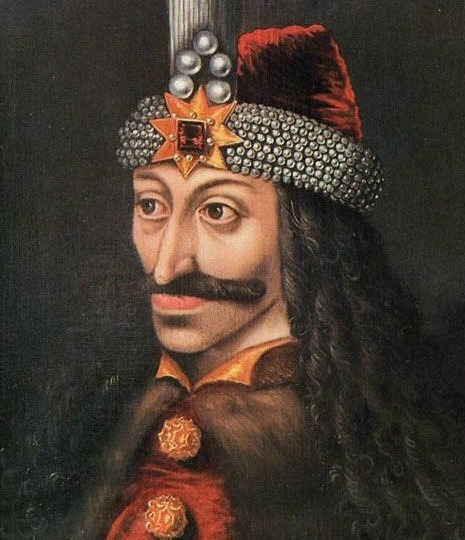
(If that isn’t the most fucking unflattering thing I’ve ever seen in my life, christ.)
When Matthias signed the armistice he had earlier concluded with the Ottomans, and a delegation from Sultan Mehmed finally made its appearance at the Hungarian summer court, the king received the Ottoman diplomats in the presence of Dracula.
He knew of the impact that this confrontation would entail, the “Impaler Prince,” even as a captive, had the power of sending shivers down the spines of the Ottoman delegates. It was a way of signaling to the king’s foes that Matthias would keep Dracula in reserve, just in case. Dracula had become something of a cryptid in the court of the Hungarian king.
Moving on, prodded by the papacy and by the promise of 80,000 gold crowns from King Matthias, Frederick III, in his characteristically unpredictable manner, finally agreed to implement the earlier accord and surrender the crown to King Matthias.
This occurred in June of 1463, when Matthias sent a delegation of 3,000 formally attired knights from the best families of Hungary to bring back the precious jeweled crown in exchange for the promised sum. The formal investiture of King Matthias took place the following year in the ancient cathedral of Esztergom with the customary pomp and ceremony. It was the first formal coronation since the days of Ladislas V, and there followed weeks of feasting and merriment in the Hungarian capital.
The son of the great Hunyadi the legitimate king. One fact that had not escaped the attention of absolutely no one in the Hungarian establishment was the presence of a little man with almond eyes, a feathered cap, and a severe countenance.
Dracula had been invited to the ceremonies of inauguration; and he was sat in a choice seat reserved for the best families of the kingdom.
(Part 4)
3 notes
·
View notes
Photo
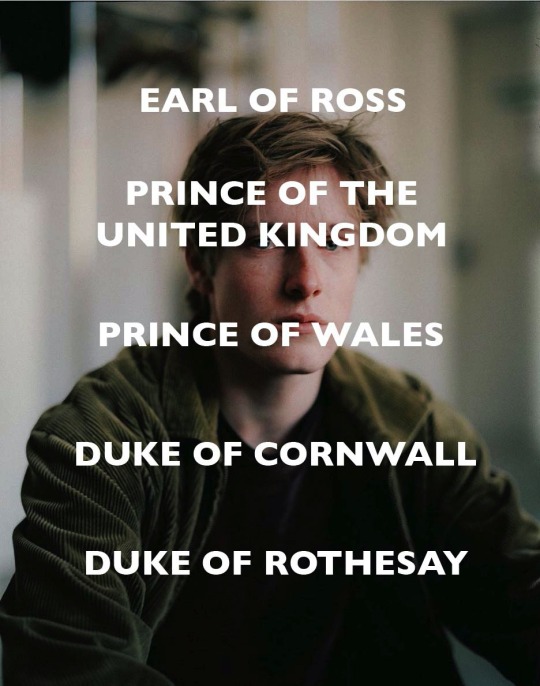
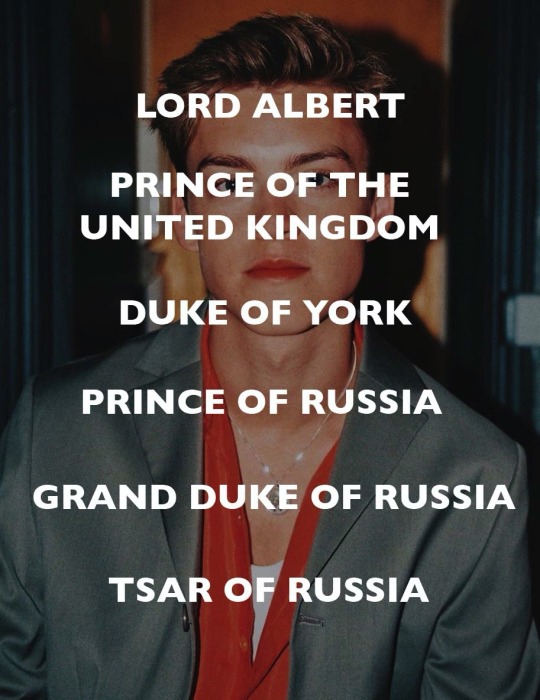

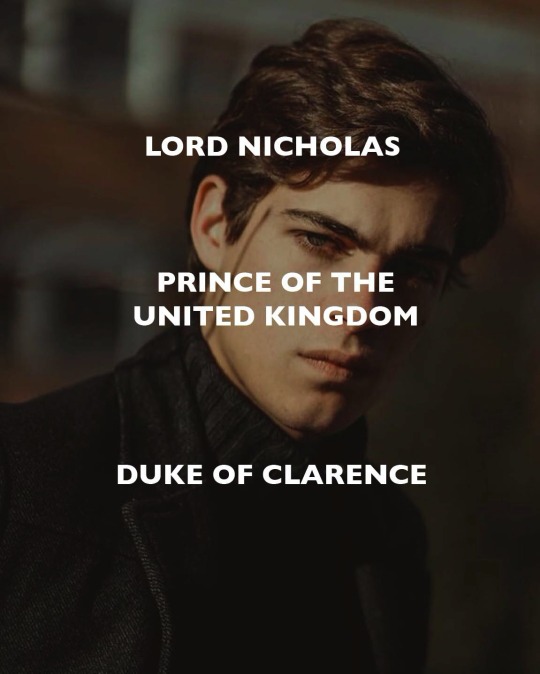


The Six Sussexes
The sons of King Henry IX and Queen Isabella
Charles, The Prince of Wales 2018-2053
Born as The Earl of Ross, Charles was the firstborn of his parent’s nine children. His childhood was marked by the struggles between his mother and the British Royal Family. His titles changed several times by the time he was 11 years old and his father’s unpredicted reign as King of the United Kingdom had made Charles the heir.
Falling under pressure, Charles began what would later become a 25-year long relationship with Count Joseph Kinsky. Charles was bi-sexual and entered non-monogamous relationships during his lifetime. The most famous of which included his relationship with Count Joseph and his marriage to Zita von Habsburg. Charles and Zita married in 2043 but his relationship with Count Joseph continued. Unlike the marriage of 3 that destroyed his paternal grandparent’s marriage, his marriage was one of love and happiness.
His marriage with Zita was part of a new era of European royalty. Zita was the only daughter of the Habsburg pretender to the Austrian-Hungarian throne. She was also the niece of the future Prince Consorts of the Netherlands, Spain, and Belgium. Her mother had been Queen Isabella’s first cousin, Princess Charlotte of Nassau. The return of the Croatian monarchy with Zita’s father as king had given Zita a more elevated position among European royalty as the daughter of a king and wife of a future king.
The couple had four children including their eldest child Charlotte who succeeded her grandfather King Henry IX as Queen Elizabeth III. Charles never became king due to his death in 2053. He and his four younger siblings died in a car crash in France several months after the death of their mother in 2052.
Albert, Alexander, The Tsar of Russia 2018-2053
Albert was born a lord but like his siblings, his titles changed until the ascension of his father as King of the United Kingdom. His childhood was best remembered as being in a relationship with Grand Duchess Maria Olga Georgievna of Russia. The two had begun a relationship at just 13 years old as Albert fell in love with the idea of becoming Tsar of Russia and Maria Olga fell in love with the family stability Albert gave her.
The marriage was initially made for the couple’s 18th birthday was postponed until their 21st birthday. Albert and Maria Olga did not wait as they married in 2038. Albert converted to Russian orthodoxy, renamed Alexander, and given the title Grand Duke Alexander Feodorovich of Russia. Despite rumors and doubts, the marriage was happy producing five children of which only one son.
Albert’s early death in 2053 placed his six-year-old son Alexander on the throne under the regency. While having children who married into various royal families his daughters made famous marriages. Albert’s grandchildren included Tsar Alexander VI of Russia, King Harald VI of Norway, King Oscar III of Sweden, and King Christian XII of Denmark representing a new era of Scandinavianism.
Robert, Duke of Sussex 2023-2053
Born as the middle son of six, Robert struggled to find his identity. He was the first son to be born a Prince of Sussex but did not have any memories of his mother’s struggles with his paternal family. Like most of his siblings, he married young, at the age of 22 to his triple third cousin Princess Maria Theresa of Ligne.
What was meant to be an escape from his family quickly turned into a nightmare. Robert believed starting a family would give him character but the couple were ill-matched for each other. Robert took after his mother in being more socially liberal and intellectual. Maria Theresa was a simple woman who was famously religious. The two had four daughters before Robert’s death in 2053.
The desire for a son was Maria Theresa’s only goal and ignored her daughters leaving Robert to take care of them. The death of his mother in 2052 and his five older siblings weeks later in 2053 left him with depression. While not seeking help, Robert passed away from what was later revealed to be suicide. At first, the death was announced as a brain aneurysm but revealed later that Robert died from a self-inflicted gunshot wound to the head.
After Robert’s death, Maria Theresa brought their daughters up in a strict religious background at home and the girls found the only escape from their mother was marriage. The Sussex daughters were not well educated and when compared to their various cousins, proved to be shy and not well-read. Robert’s four daughters married Catholic relatives but only one of Robert’s grandchildren married a king. His granddaughter Archduchess Claudia of Austria married the King of Croatia. His daughter’s converted to Catholicism thus being barred from the British line of succession.
Nicholas, Duke of Clarence 2023-2122
The longest living siblings was Nicholas, the seventh born child of King Henry and Queen Isabella. His twin brother was Prince Robert and their birth made history as the first second set of twins in the British Royal history. Like his siblings, he married young and to a second cousin, Princess Maria Anna of Liechtenstein.
Mirroring his parents, Nicholas had nine children including having three daughters and six sons. His marriage in 2046 was monumental as Buckingham Palace announced that Prince Nicholas converted to Catholicism months after the wedding. The choice was the first to happen in centuries, but Nicholas and his family continued to support the British Royal Family since his brother Albert was in Russia and his sister’s moved to foreign courts.
The marriage was happy and historic as Maria Anna was the first Princess of Liechtenstein to marry into the British Royal Family. Two of Nicholas’ children married into monarchs. Prince Maximilian, the third child and third son, married the future Queen Wilhelmina II of the Netherlands. Nicholas became the grandfather of Queen Juliana II of the Netherlands.
Sophia, the youngest of Nicholas and Maria Anna’s children married Henri, the future Prince of Monaco. Through this marriage, Nicholas became the grandfather of Prince Rainer IV of Monaco. Nicholas’ other children married into various royal families including the Croatian, Belgian, and Spanish Royal Families.
Joseph, Duke of Suffolk 2024-2104
As the eighth youngest child, Joseph was often doted on by his mother. Unlike his elder siblings, Joseph spent much time in French never learning English until his father was years into his reign. Following the footsteps of his older brother, Joseph converted to Catholicism in 2046 with the intention of marrying the Catholic Princess Astrid of Belgium. The young couple had been together
Joseph and Astrid had six children and their grandchildren were scattered across Europe. Through their eldest son Prince Amedeo, Joseph is the grandfather of Queen Eugenie of Belgium. Through their eldest daughter and second child, Princess Stephanie, Joseph and Astrid were the grandparents of Queen Eleanor of the United Kingdom nee Princess of Nassau. As a son of the United Kingdom, his Catholic Nassau granddaughter marrying the future King of the United Kingdom was historical.
From two more sons, Joseph became the grandfather to Elena, The Princess of Monaco and Dagmar, Tsarina Maria Feodorovna of Russia. His other children married into the Luxembourgish and Belgian Royal Families.
Michael, Duke of Kendal 2026-2121
The youngest child of nine, Michael was his mother’s favorite. With faint memories of his grandfather, Michael was only 3 years old at the death of his grandfather George VII, the abdication of his uncle William V, and the beginning of the reign of his father Henry IX.
Michael was the only of his siblings to not marry a princess, instead, he married his second cousin Countess Alexandrine de Monpezat. Countess Alexandrine’s father was Prince Nikolai of Denmark and her great-grandmother was Queen Margrethe II of Denmark. As a Danish noble, Alexandrine's life was modest but her mother was a first cousin of Michael’s mother, Queen Isabella. Alexandrine and Michael spent their childhood together in France.
Their marriage occurred in 2049, at which Michael remained in the line of succession. Because his several of his elder brothers became Catholics and two of his sisters also became Catholics after their marriages, Michael was placed behind his siblings Charles, Albert, and Mary-Astrid and their respective children.
Michael and Alexandrine had seven children together including their daughter Isabella becoming Queen of Spain. Through his children’s marriages, Michael is the grandfather of Queen Henrietta of Denmark, Queen Alexandrine of Norway, and King Alfonso XV of Spain. The rest of his children married into the Croatian, Romanian, Danish, and Luxembourgish Royal Families.
8 notes
·
View notes
Note
You've talked before about the "protuberant eyes of the Hanovers". That made me major book vibes (think about the Stark look or Lannister look), and it made me curious; are there any distinct phyisical traits in real-life monarchies?
Ohhh boy let me tell you about perhaps the most infamous of all royal genetic markers: the Hapsburg jaw.
The House of Hapsburg (or Habsburg, as its original castle was called) needs virtually no introduction. Once a minor noble family from present-day Switzerland, the family ascended in power in the medieval period until it controlled the Duchy of Austria and one of its scions, Frederick III, was elected Holy Roman Emperor. Through the marriage of Philip, Duke of Burgundy to Juana of Castile, the Hapsburg empire expanded greatly, with the family controlling both its territories in the Holy Roman Empire and the territories of the recently united Spain (this is why the arms of their son Charles V were so complicated). The senior branch of the family ruled Spain until the death of Charles II in 1700, while the junior branch ruled the Holy Roman Empire until 1780 (with the death of Maria Theresa, the last of that male line, though the family continued to style itself as “Hapsburg” thereafter, even down to the modern pretender Karl von Habsburg).
Unrelated to their imperial ambitions, the Hapsburgs also tended to have very pronounced, Jay Leno-esque lower jaws - the result of a condition known as “mandibular prognathism”. No one is quite certain when the trait came into the family: popular legend has it that the Polish noblewoman Cymburga of Masovia, the mother of Holy Roman Emperor Frederick III, brought the trait into the family, but it can also be seen in more distant ancestors as well. Certainly, however, by the sixteenth century the Hapsburg jaw (or Hapsburg lip) was pretty evident in a number of members of the family.
So, for example, here’s Charles V, Holy Roman Emperor and King of Spain:
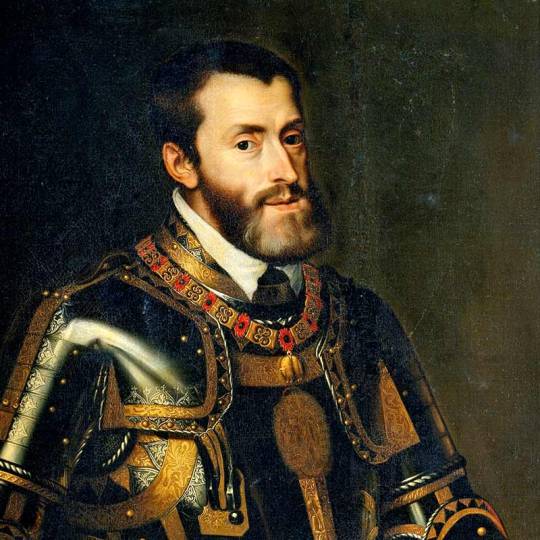
Here’s his son, Philip II of Spain:

Here’s his daughter-in-law, Margaret of Austria (who was also a granddaughter of Charles V’s younger brother Ferdinand I, Holy Roman Emperor):
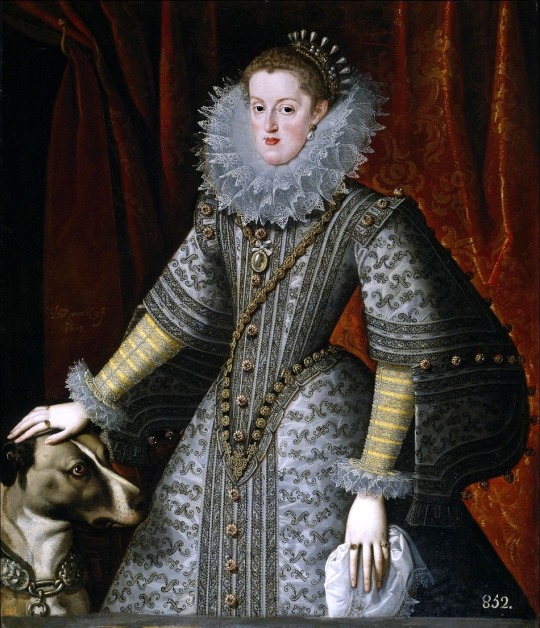
Here’s Philip II’s grandson, Philip IV:
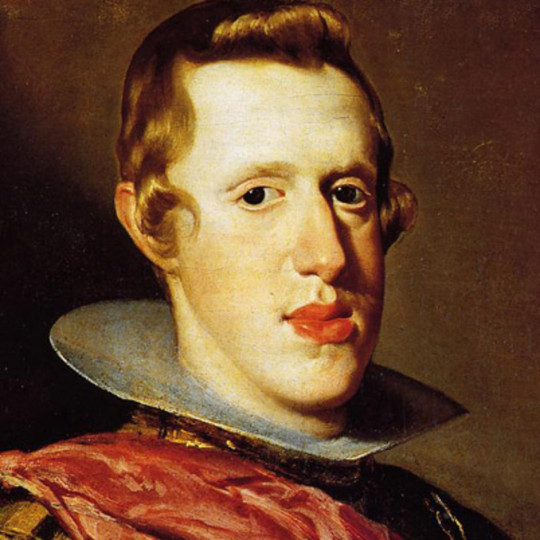
And Philip IV’s younger brother, the Infante Charles:
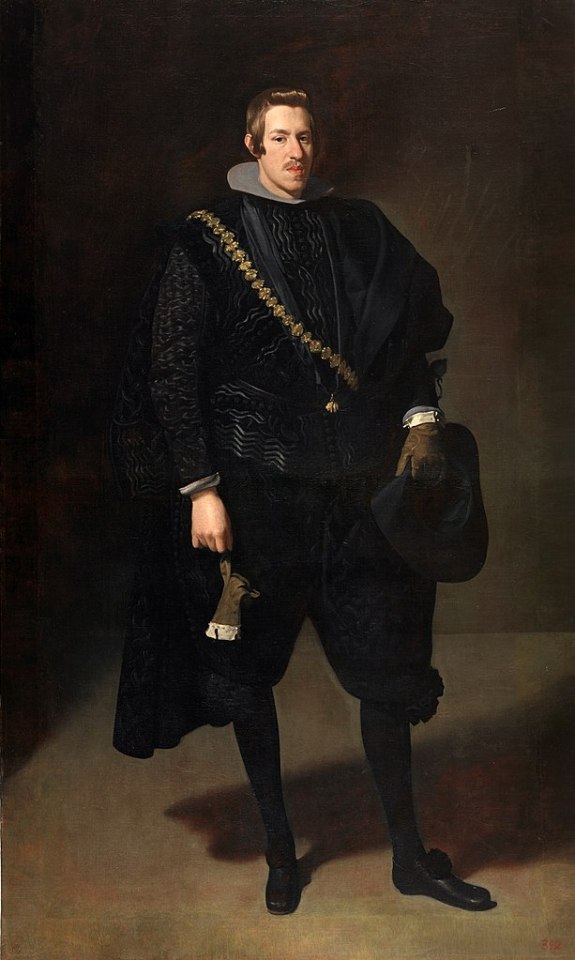
It got really bad in Philip IV’s only surviving son, Charles II (who, I can’t emphasize enough, was more inbred than if his parents had actually been siblings):

(Poor Charles’ case was so bad that he had great difficulty speaking and chewing, as his overlarge tongue could not fit completely in his mouth)
There was also Ferdinand I’s grandson Ferdinand II, Holy Roman Emperor:
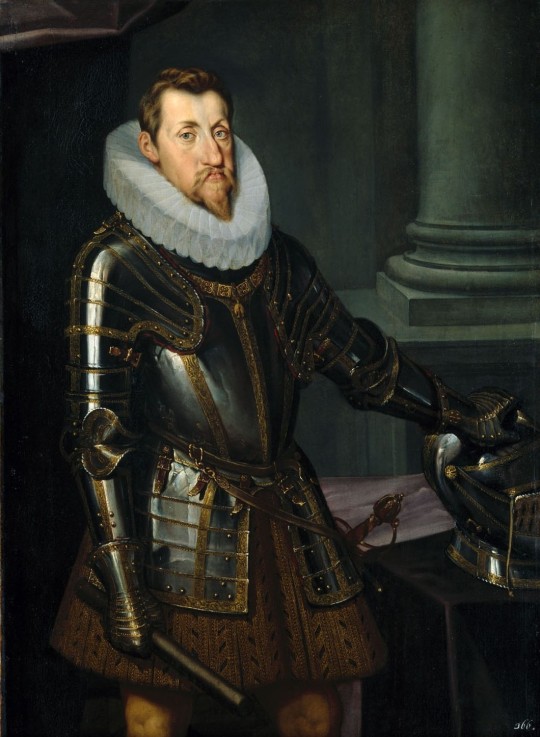
And another grandson of Ferdinand I, Archduke Ernest:
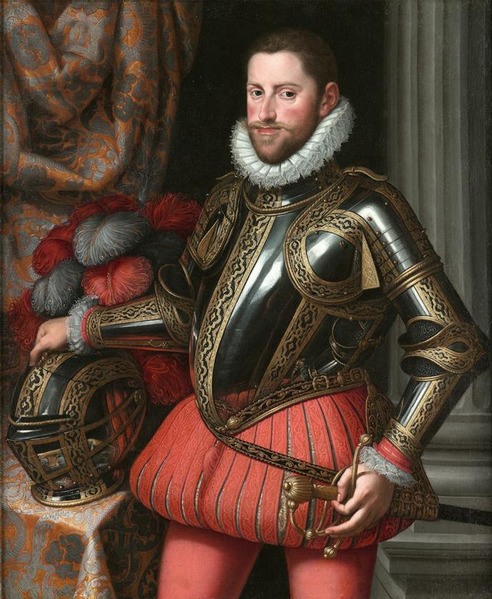
As well as Ferdinand II’s grandson Leopold I, Holy Roman Emperor:
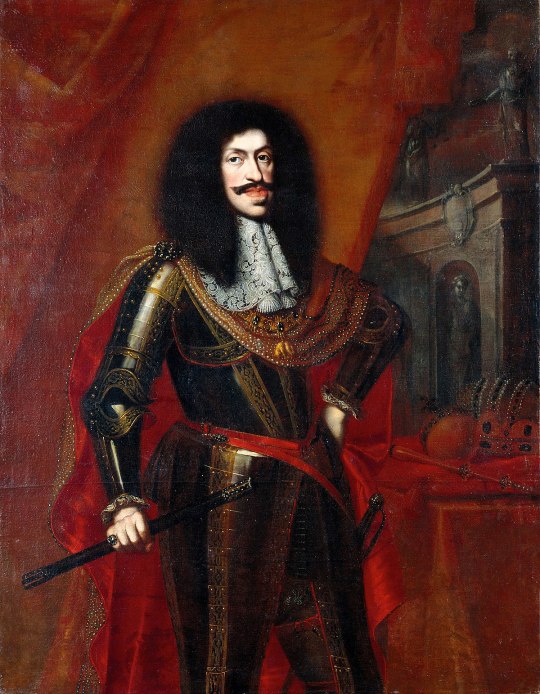
It continued even into more modern Hapsburg descendants, like Ferdinand I, Austrian Emperor:

(To continue the inbreeding, Ferdinand I’s parents were double first cousins: his paternal grandfather, Leopold II, Holy Roman Emperor, was the brother of his maternal grandmother, Maria Carolina of Austria, while his maternal grandfather, Ferdinand I of Naples and Sicily, was the brother of his paternal grandmother, Maria Luisa of Spain. Poor Ferdinand suffered from hydrocephalus and severe epilepsy, as well as several neurological problems that made learning speech difficult for him.)
And one of Ferdinand I’s first cousins, Archduke Albert:
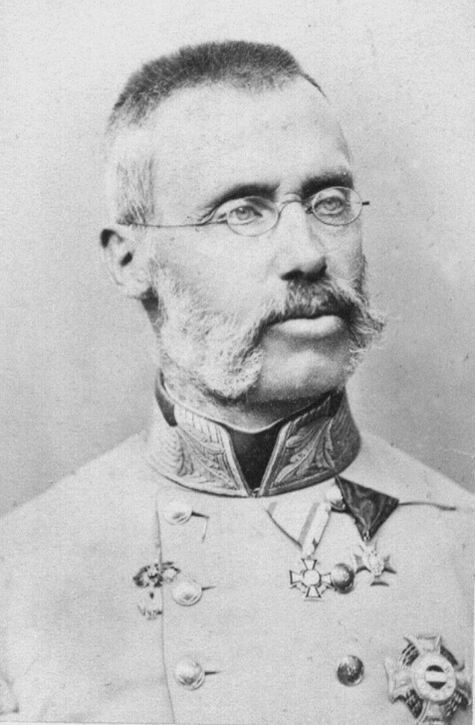
Even King Alfonso XIII of Spain (whose mother, Maria Christina of Austria, was Archduke Albert’s niece):
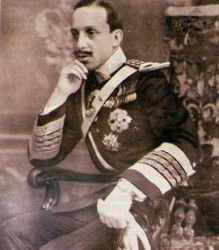
These are just some of the many Hapsburgs, and of course the trait did not always appear (even as inbred as many of the Hapsburgs were, there were non-Hapsburg marriages among them). Of course, that’s true for the families of Westeros as well: the Starks might be long-faced, grey-eyed, and dark-haired, but only one of the Stark-Tully children ended up with those features; there were plenty of Targaryen descendants who did not show the family’s famous silvery hair and purple eyes; and while Lannisters are often blond-haired and green eyes, there’s every probability (h/t @joannalannister) that red-haired Dancy the prostitute is the daughter of a Lannister.
107 notes
·
View notes
Text
Top 15 Interesting St. Stephen's Cathedral Facts

One of the most fascinating Gothic Cathedrals in the world can be found in the historical heart of the capital of Austria, Vienna.
In this post, you'll discover the ultimate list of interesting facts about St. Stephen's Cathedral, an amazing church with a remarkable history commonly known as the Stephansdom.
1. The original church was built on an Ancient Roman cemetery
During the reign of Roman Emperor Augustus, in the year 15 B.C., the Romans built a fortified structure to protect a military camp that they had built on the site where the Austrian capital of Vienna is located now.
They referred to the city they had founded as "Vindobona," which translates to "fair village, white settlement," and which is probably how modern-day Vienna got its name.
It's only during the year 2000 that ancient graves were discovered about 2.5 meters (8.2 feet) below the surface. This means that the cathedral was built on the remains of an ancient Roman cemetery.

View of the church in Vienna / Pixabay
2. The Romanesque towers were completed in the mid-13th century
The original church on the site was built in the 12th century in the Romanesque architectural style. It was founded in the year 1137 and the initial construction phase was completed in 1147, which is the year the church was dedicated to Saint Stephen.
This was an important event as it was the moment that Conrad III of Germany and his gang were getting ready to start their Second Crusade (1147-1150).
The first church on the site was completed in the year 1160 and subsequently expanded between 1230 and 1245. This is when the 2 magnificent Romanesque towers we can still see today were completed.
These towers stand 65 meters (213 feet) tall and are commonly referred to as the "Heidentürme," a reference to the fact that they were built on top of the Roman fortification. "Heiden" translates to "Pagans," so "Pagan Towers."
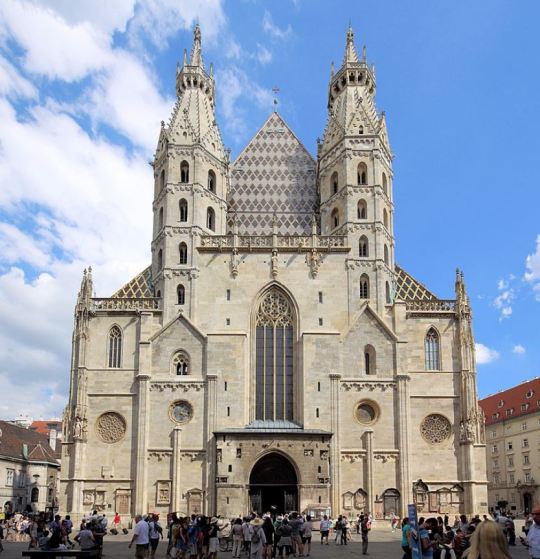
The Romanesque towers / Bwag / https://creativecommons.org/licenses/by-sa/4.0
3. The second church here dates back to the 13th century as well
Even though the two Romanesque towers were completed in 1245, the structure around them doesn't date back to this period. That's because a great fire destroyed much of the structure in 1258, except for these two towers.
The towers were simply incorporated into an even bigger structure which was completed and dedicated shortly after on April 23, 1263.
One of the most remarkable facts about St. Stephen's Cathedral is that this dedication in the 13th century is still commemorated every year. On this day, the big bells inside the tower ring for 3 minutes straight.
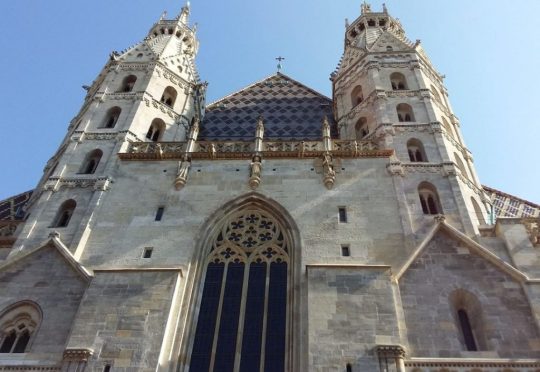
Detail of the old Romanesque part of the cathedral / Pixabay
4. The Gothic church we see today was finally completed in 1511
It didn't take long before another expansion phase was started, this time in the Gothic architectural style. In the early 14th century, King Albert I commissioned the Gothic choir which consists of 3 naves.
This work was completed between 1304 and 1340 and dedicated by Albert's son, Albert II. This wasn't enough because Albert I's grandson, Rudolph IV or "Rudolph the Founder," started the construction of the westward Gothic extension of the church.
The overall design of the church we see today with all its features was completed in 1511, the year that construction on the cathedral was halted altogether.

View of the Gothic additions to the cathedral / Pixabay
5. The main spire reaches the height of a modern-day skyscraper
During the final expansion phase, the church was seriously enlarged. It has a total length of 107 meters (351 feet) and a width of 70 meters (230 feet).
The most prominent feature of this fascinating cathedral is the southern tower of which the spire reaches a height of 136.7 meters (448 feet).
This tower was completed in 1433 and its height is the equivalent of an amazing skyscraper which turns it into the most dominant building in the area.

Drawing of the cathedral in 1847 / Wiki Commons
6. The north tower was intended to resemble its taller brother
The church could have been even more imposing if the original plan was completed. This would have turned the north tower into the twin brother of the south tower, but this plan was eventually abandoned when work seized in 1511.
The construction of this tower was started in 1450 and it eventually reached a height of 68.3 meters (224 feet). Because the original plans were abandoned, this tower was topped with a Renaissance roof in the year1568, a common feature during the 16th century.

The north and south tower of the cathedral / Bwag / https://creativecommons.org/licenses/by-sa/4.0
7. The main door is probably named after a prehistoric animal
The main entrance of the church has its own name as it's referred to as the "Riesentor," or the "Giant's Door." There are a couple of theories as to why it's referred to as such, but it's assumed that it refers to the thighbone of a mammoth, a giant prehistoric animal.
This thighbone was excavated during the construction in 1443 and dangled above this door for multiple decades. To both sides of this door we can find the old Romanesque towers from the 13th century.

Detail of the Riesentor / Uoaei1 / https://creativecommons.org/licenses/by-sa/3.0/deed.en
8. The most amazing feature of the church is its tiled roof
One of the most amazing facts about St. Stephen's Cathedral is that it features a magnificent roof that is covered with a grand total of 230,000 glazed tiles.
This roof has a length of 111 meters (364 feet) and the south side depicts the symbol of the Austrian Empire under Habsburg rule, the double-headed eagle.
The north side of the north depicts the coat of arms of both the City of Vienna and of the Republic of Austria, a remarkable sight to behold!
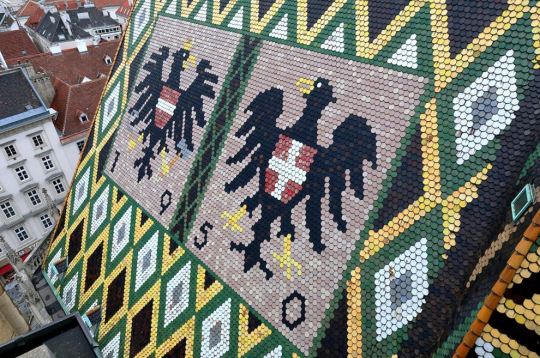
Detail of the tiled roof / Bwag / https://creativecommons.org/licenses/by-sa/4.0
9. It's home to the third-largest swinging bell in Europe
The cathedral's towers are home to a total of 23 ringing bells. The largest of them all is called the "Pummerin," or "Boomer," and is located inside the north tower.
The original Pummerin was cast from 208 cannons captured from Muslim invaders during the Second Turkish Siege of Vienna in 1683. This enormous bell weighed 18,161 kilos (40,038 lbs) and it took over 15 minutes of 16 men pulling on a rope for the bell to ring.
Unfortunately, this old bell was destroyed in the aftermath of World War II and replaced with the "New Pummerin" in 1951. The new bell weighs even more at 20,130 kilos (44,380 lbs), a weight that makes it the third-heaviest swinging bell in Europe.
Only the Petersglocke in Cologne Cathedral (23,500 kg / 51,810 lbs) and the Maria Dolens (22,700 kilos / 50,044 lbs) in Rovereto, Italy, are heavier.
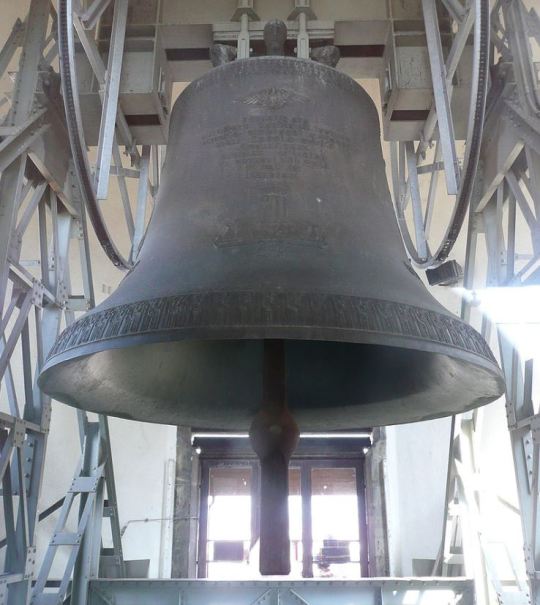
The famous Pummerin / Gryffindor / https://creativecommons.org/licenses/by-sa/3.0
10. A presumed miracle brought a Hungarian icon to the church
The interior of the cathedral is equally impressive as the exterior and multiple famous works of art can be found here. One of these is the "Pötscher Madonna," a Byzantine-style icon of St. Mary with baby Jesus that
It was created in 1676 and brought to the church in the late 17th century from the church of Pócs in Hungary for a particular reason.
After Holy Roman Emperor Leopold I received the word of the icon shedding tears on two different occasions, he ordered to be brought to Austria. It arrived in Vienna after a 5-month journey in 1697 but hasn't been seen shedding tears since.
It can now be found in the southwest corner of the nave of the cathedral.

Pötscher Madonna / Bwag / https://creativecommons.org/licenses/by-sa/4.0
11. The 15th-century Altar underwent a costly 20-year restoration
The High Altar is the first one a visitor notices when entering the church. This Baroque altar was completed between 1641 and 1647 and represents the stoning of Saint Stephen, the martyr to whom the church was dedicated.
The other famous altar in the church is the so-called Wiener Neustädter Altar, an altar that was commissioned by Emperor Frederick III in the year 1447.
This altar wasn't moved to the cathedral until 1885 as it originally decorated the Cistercian Viktring Abbey near Klagenfurt (until 1776) and the Cistercian monastery of St. Bernard of Clairvaux in Wiener Neustadt.
On its 100th anniversary in the church in 1985, a restoration program was started which would take 20 years to complete at a cost of 1.3 million Euro.
It's only opened during weekends and opened up it depicts events in the life of the Virgin Mary. If closed, it depicts a painting involving 72 saints.

Wiener Neustädter Altar / Bwag / https://creativecommons.org/licenses/by-sa/4.0
12. A sculptor probably eternalized himself below the pulpit's chair
One of the most remarkable works of art is the stone-cut pulpit which is situated against one of the pillars of the nave of the cathedral. The sculptor is believed to be Dutch-born Nikolaus Gerhaert (1420-1473), but he didn't manage to steal the show so-to-speak.
Below the pulpit, we can see the image of a man peaking through a window. This is believed to be a self-portrait of an unidentified sculptor who is referred to as the "Fenstergucker," or "Window Peaker."

Fenstergucker in St. Stephen's Cathedral / Uoaei1 / https://creativecommons.org/licenses/by-sa/3.0/deed.en
13. Some very famous people are buried inside the church
The Dutch sculptor who created the magnificent pulpit is also responsible for the creation of the tomb of Emperor Frederick III (1415-1493). This work started 25 years before his death and would take 45 years to complete.
He's far from the only person who ended up being buried in the church as it's also the final resting place of Prince Eugene of Savoy (1663-1736) and 72 other members of the Habsburg Dynasty of the Austrian Empire whose remains are in the crypt.
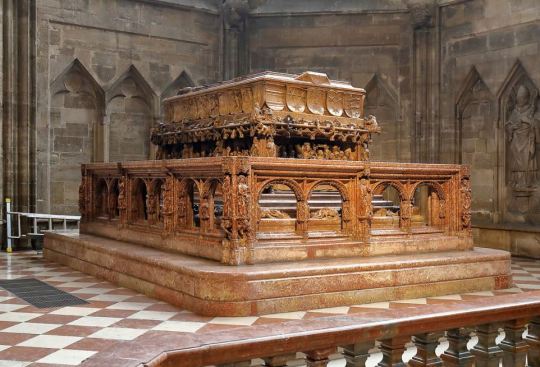
Tomb of Emperor Frederick III / Bwag / https://creativecommons.org/licenses/by-sa/4.0
14. The south tower was completely restored in the 2000s
During the 2000s, the exterior of the church has been restored as the accumulated dirt turned most parts of the stones completely black. The most prominent feature of the church, the south tower, was restored as well.
This restoration project, which mostly involved cleaning the limestone) was finally completed in the year 2008 and the south tower pretty much looks brand new again!
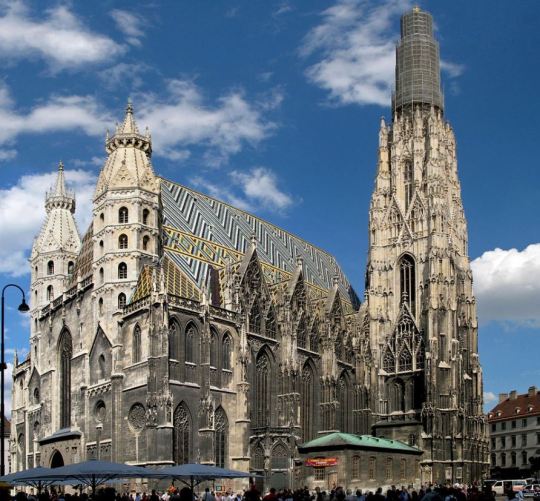
The south tower during restoration / Andrew Bossi / https://creativecommons.org/licenses/by-sa/2.5
15. The interior looks amazing after a renovation as well
One of the most fascinating facts about St. Stephen's Cathedral is that the interior looks amazing as well, especially following a similar renovation project.
The cathedral features several chapels which are adorned with statues and amazing works of art. This means that entering the church is a must-do item on your Vienna bucket list!
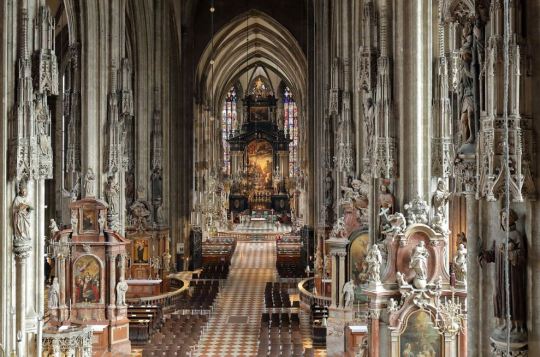
The amazing interior of the Vienna Cathedral / Bwag / https://creativecommons.org/licenses/by-sa/4.0
Read the full article
#Architecture#Churches#famouschurches#famouschurchesintheworld#FamousGothicCathedrals#LandmarksinVienna#MostfamousGothicCathedrals#StStephensCathedral#StStephensCathedralfacts#Vienna
1 note
·
View note
Text
Events 7.2
437 – Emperor Valentinian III begins his reign over the Western Roman Empire. His mother Galla Placidia ends her regency, but continues to exercise political influence at the court in Rome.
626 – Li Shimin, the future Emperor Taizong of Tang, ambushes and kills his rival brothers Li Yuanji and Li Jiancheng in the Xuanwu Gate Incident.
706 – In China, Emperor Zhongzong of Tang inters the bodies of relatives in the Qianling Mausoleum, located on Mount Liang outside Chang'an.
866 – Battle of Brissarthe: The Franks led by Robert the Strong are defeated by a joint Breton-Viking army.
936 – King Henry the Fowler dies in his royal palace in Memleben. He is succeeded by his son Otto I, who becomes the ruler of East Francia.
963 – The Byzantine army proclaims Nikephoros II Phokas Emperor of the Romans on the plains outside Cappadocian Caesarea.
1298 – The Battle of Göllheim is fought between Albert I of Habsburg and Adolf of Nassau-Weilburg.
1494 – The Treaty of Tordesillas is ratified by Spain.
1504 – Bogdan III the One-Eyed becomes Voivode of Moldavia.
1555 – Ottoman Admiral Turgut Reis sacks the Italian city of Paola.
1561 – Menas, emperor of Ethiopia, defeats a revolt in Emfraz.
1582 – Battle of Yamazaki: Toyotomi Hideyoshi defeats Akechi Mitsuhide.
1613 – The first English expedition (from Virginia) against Acadia led by Samuel Argall takes place.
1644 – English Civil War: Battle of Marston Moor.
1645 – Battle of Alford: Wars of the Three Kingdoms.
1698 – Thomas Savery patents the first steam engine.
1776 – American Revolution: The Continental Congress adopts a resolution severing ties with the Kingdom of Great Britain although the wording of the formal Declaration of Independence is not published until July 4.
1816 – The French frigate Méduse strikes the Bank of Arguin and 151 people on board have to be evacuated on an improvised raft, a case immortalised by Géricault's painting The Raft of the Medusa.
1822 – Thirty-five slaves, including Denmark Vesey, are hanged in South Carolina after being accused of organizing a slave rebellion.
1823 – Bahia Independence Day: The end of Portuguese rule in Brazil, with the final defeat of the Portuguese crown loyalists in the province of Bahia.
1839 – Twenty miles off the coast of Cuba, 53 kidnapped Africans led by Joseph Cinqué mutiny and take over the slave ship Amistad.
1853 – The Russian Army crosses the Prut river into the Danubian Principalities (Moldavia and Wallachia), providing the spark that will set off the Crimean War.
1864 – Dimitri Atanasescu founds the first Romanian school in the Balkans for the Aromanians in Trnovo, in the Ottoman Empire (now in North Macedonia). By the early 20th century, the number of these schools will have risen to 106.
1871 – Victor Emmanuel II of Italy enters Rome after having conquered it from the Papal States.
1881 – Charles J. Guiteau shoots and fatally wounds U.S. President James A. Garfield (who will die of complications from his wounds on September 19).
1890 – The U.S. Congress passes the Sherman Antitrust Act.
1897 – British-Italian engineer Guglielmo Marconi obtains a patent for radio in London.
1900 – The first Zeppelin flight takes place on Lake Constance near Friedrichshafen, Germany.
1900 – Jean Sibelius' Finlandia receives its première performance in Helsinki with the Helsinki Philharmonic Society conducted by Robert Kajanus.
1921 – World War I: U.S. President Warren G. Harding signs the Knox–Porter Resolution formally ending the war between the United States and Germany.
1934 – The Night of the Long Knives ends with the death of Ernst Röhm.
1937 – Amelia Earhart and navigator Fred Noonan are last heard from over the Pacific Ocean while attempting to make the first equatorial round-the-world flight.
1940 – Indian independence leader Subhas Chandra Bose is arrested and detained in Calcutta.
1940 – The SS Arandora Star is sunk by U-47 in the North Atlantic with the loss of over 800 lives, mostly civilians.
1962 – The first Walmart store, then known as Wal-Mart, opens for business in Rogers, Arkansas.
1964 – Civil rights movement: U.S. President Lyndon B. Johnson signs the Civil Rights Act of 1964 meant to prohibit segregation in public places.
1966 – France conducts its first nuclear weapon test in the Pacific, on Moruroa Atoll.
1976 – End of South Vietnam; Communist North Vietnam annexes the former South Vietnam to form the unified Socialist Republic of Vietnam.
1986 – Rodrigo Rojas and Carmen Gloria Quintana are burnt alive during a street demonstration against the dictatorship of General Augusto Pinochet in Chile.
1986 – Aeroflot Flight 2306 crashes while attempting an emergency landing at Syktyvkar Airport in Syktyvkar, in present-day Komi Republic, Russia, killing 54 people.
1988 – Marcel Lefebvre and the four bishops he consecrated were excommunicated by the Holy See.
1990 – In the 1990 Mecca tunnel tragedy, 1,400 Muslim pilgrims are suffocated to death and trampled upon in a pedestrian tunnel leading to the holy city of Mecca.
1994 – USAir Flight 1016 crashes near Charlotte Douglas International Airport, killing 37 of the 57 people on board.
1997 – The Bank of Thailand floats the baht, triggering the Asian financial crisis.
2000 – Vicente Fox Quesada is elected the first President of México from an opposition party, the Partido Acción Nacional, after more than 70 years of continuous rule by the Partido Revolucionario Institucional.
2001 – The AbioCor self-contained artificial heart is first implanted.
2002 – Steve Fossett becomes the first person to fly solo around the world nonstop in a balloon.
2005 – The Live 8 benefit concerts takes place in the G8 states and in South Africa. More than 1,000 musicians perform and are broadcast on 182 television networks and 2,000 radio networks.
2008 – Colombian conflict: Íngrid Betancourt, a member of the Chamber of Representatives of Colombia, is released from captivity after being held for six and a half years by FARC.
2010 – The South Kivu tank truck explosion in the Democratic Republic of the Congo kills at least 230 people.
2013 – The International Astronomical Union names Pluto's fourth and fifth moons, Kerberos and Styx.
2013 – A magnitude 6.1 earthquake strikes Aceh, Indonesia, killing at least 42 people and injuring 420 others.
0 notes
Note
Hi!!b What are your favorite royal names? 💖
Someone needs to come physically force me to stop being so extra
Princess Katharina Clementine Beatrix of Hohenlohe-Langenburg
Princess Sophie Amelie Adelheid Louise Johanne Leopoldine of Löwenstein-Wertheim-Rosenberg
Princess Joséphine-Charlotte Stéphanie Ingeborg Elisabeth Marie-José Marguerite Astrid of Belgium, Grand Duchess of Luxembourg
Princess Maud Charlotte Mary Victoria of Wales, Queen of Norway
Prince August Wilhelm of Prussia
King Vittorio Emanuele Ferdinando Maria Gennaro III of Italy
Franz Joseph Otto Robert Maria Anton Karl Max Heinrich Sixtus Xavier Felix Renatus Ludwig Gaetan Pius Ignatius von Habsburg, Archduke of Austria
Grand Duke Henri Albert Gabriel Félix Marie Guillaume of Luxembourg
#i hate myself#cornwallcambridge answers questions#names#royal#i got carried away#boy names are hard#they're all named george#otto is so cute tho#i apologize for this#it's bad#baby names#what do i tag#royal family#Anonymous
0 notes
Photo
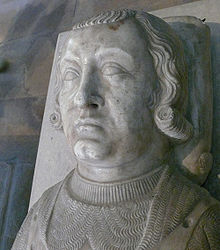
Today history, March 12, 1270, the birth of Charles, Count of Valois:
"Charles of Valois (12 March 1270 – 16 December 1325) was the third son of Philip III of France and Isabella of Aragon. He was a member of the House of Capet and founded the House of Valois. In 1284, he was created Count of Valois (as Charles I) by his father and, in 1290, received the title of Count of Anjou from his marriage to Margaret of Anjou. Through his marriage to Catherine I, titular empress of the Latin Empire, he was titular Latin Emperor of Constantinople from 1301–1307, although he ruled from exile and only had authority over Crusader States in Greece.
Moderately intelligent, disproportionately ambitious and quite greedy, Charles of Valois collected principalities. He had as appanage the counties of Valois, Alençon and Perche (1285). He became in 1290 count of Anjou and of Maine by his marriage with Margaret, eldest daughter of Charles II, titular king of Sicily; by a second marriage, contracted with the heiress of Baldwin II de Courtenay, last Latin emperor of Constantinople, he also had pretensions on this throne. But he was son, brother, brother-in-law, son-in-law, and uncle of kings or of queens (of France, of Navarre, of England, and of Naples), becoming, moreover, after his death, father of a king (Philip VI).
Charles thus dreamed of more and sought all his life for a crown he never obtained. In 1285, the pope recognized him as King of Aragon (under the vassalage of the Holy See), as son of his mother, in opposition to King Peter III, who after the conquest of the island of Sicily was an enemy of the papacy. Charles then married Marguerite of Sicily, daughter of the Neapolitan king, in order to re-enforce his position in Sicily, supported by the Pope. Thanks to this Aragonese Crusade undertaken by his father Philip III against the advice of his brother, the future Philip the Fair, he believed he would win a kingdom and won nothing but the ridicule of having been crowned with a cardinal's hat in 1285, which gave him the sobriquet of the "King of the Cap." He would never dare to use the royal seal which was made on this occasion and would have to renounce the title.
His principal quality was to be a good military leader. He commanded effectively in Flanders in 1297. The king quickly deduced that his brother could conduct an expedition in Italy against Frederick II of Sicily. The affair was ended by the peace of Caltabellotta.
Charles dreamed at the same time of the imperial crown and married in 1301 Catherine de Courtenay, who was a titular empress. But it needed the connivance of the Pope, which he obtained by his expedition to Italy, where he supported Charles II of Anjou against Frederick II of Sicily, his cousin. Named papal vicar, he lost himself in the imbroglio of Italian politics, was compromised in a massacre at Florence and in sordid financial exigencies, reached Sicily where he consolidated his reputation as a looter and finally returned to France discredited in 1301-1302.
Charles was back in shape to seek a new crown when the German king Albert of Habsburg was murdered in 1308. Charles's brother, who did not wish to take the risk himself of a check and probably thought that a French puppet on the imperial throne would be a good thing for France, encouraged him. The candidacy was defeated with the election of Henry VII as German king. Charles continued to dream of the eastern crown of the Courtenays.
He did benefit from the affection which Philip the Fair, who had suffered from the remarriage of their father, brought to his only full brother, and he found himself given responsibilities which largely exceeded his talent. Thus it was he who directed in 1311 the royal embassy to the conferences of Tournai with the Flemish; he quarreled there with his brother's chamberlain Enguerrand de Marigny, who openly flouted him. Charles did not pardon the affront and would continue the vendetta against Marigny after the king's death.
He was doggedly opposed to the torture of Jacques de Molay, grand master of the Templars, in 1314.
The premature death of Louis X in 1316 gave Charles hopes for a political role, but he could not prevent his nephew Philip, from taking the regency while awaiting the birth of Louis X's posthumous son. When that son (John I of France) died after a few days, Philip took the throne as Philip V.
In 1324, he commanded with success the army of his nephew Charles IV (who succeeded Philip V in 1322) to take Guyenne and Flanders from King Edward II of England. He contributed, by the capture of several cities, to accelerate the peace, which was concluded between the king of France and his niece, Isabella, queen-consort of England.
The Count of Valois died 16 December 1325 at Nogent-le-Roi, leaving a son who would take the throne of France under the name of Philip VI and commence the branch of the Valois: a posthumous revenge for the man of whom it was said, "Son of a king, brother of a king, uncle of three kings, father of a king, but never king himself." Charles was buried in the now-demolished church of the Couvent des Jacobins in Paris - his effigy is now in the Basilica of St Denis."
9 notes
·
View notes
Photo
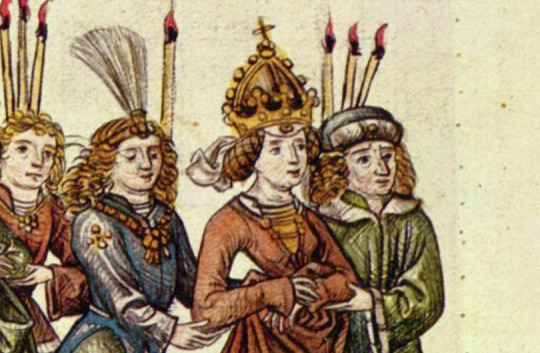
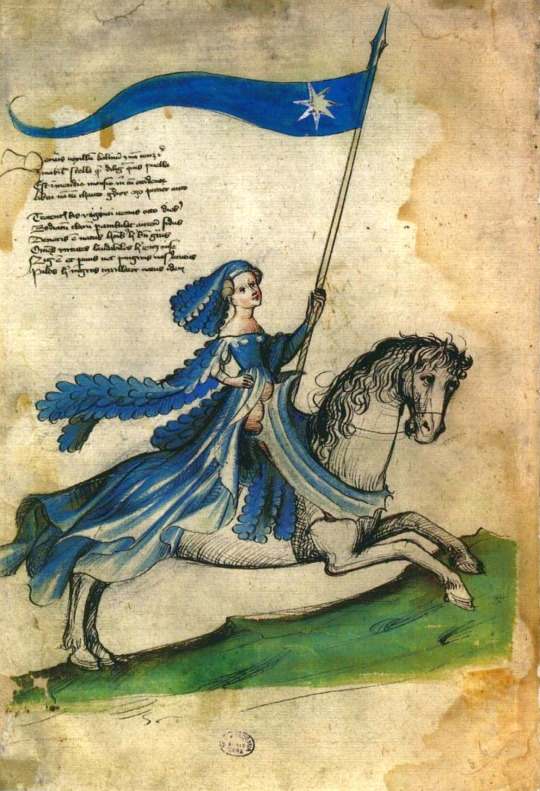
Barbara of Celje (also Barbara of Cilli) was (most likely) born in 1392 as the 5th and youngest child of count Hermann II of Celje and countess Anna of Schaunberg. Through her marriage to Sigismund of Luxembourg, which (probably) occured in 1405, she was Queen of Hungary (1405), Queen of the Romans (1411), Queen of Bohemia (1419) and Holy Roman Empress (1433).
The Counts of Celje were a prominent late medieval family, rising from the position of mere vassals to the Habsburgs (with whom they were often in conflict) to Princes of the Holy Roman Empire subordinate only to the Emperor in a relatively short time span, owing mainly to the political ability and military prowess of Barbara’s father Hermann. By saving the life of Sigismund of Luxembourg not once, but twice (first in the Battle of Nicopolis against the Ottomans in 1396 and then again when he was kidnapped by the Hungarian nobility in 1401), Hermann ensured his youngest daughter Sigismund’s hand in marriage. The Celje family was a good choice for Sigismund as well, since they were contenders for the Bosnian throne (and they eventually became heirs presumptive in 1427), had good connections in the Balkans (Hermann’s eldest son Frederick was married to Elisabeth of Frankopan, Frankopans being the most influential family in the region at the time), but also because Barbara’s cousin Anna of Celje was the new Polish queen (by marrying her – the granddaughter of Casimir III who was the last Polish king of the Piast dynasty – Vladislaus II Jagiellon solidified his rule after the death of his wife Jadwiga, queen regnant of Poland).
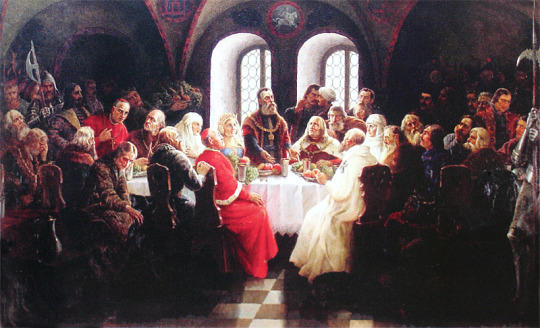
Queen Barbara herself was an important figure, serving as regent when Sigismund was absent and she was a capable manager of her own fiefdoms. Alongside her husband, she appeared at the Council of Constance (1414-1418) (the two pictures at the top {x} {x}), which ended the Western Schism, and the Congress of Lutsk (1429) (the picture above {x}, Sigismund can be seen standing in the centre with Barbara sitting on his right). She was instrumental in creating the Order of the Dragon (1408), whose most notable member is probably Vlad III Dracul or Vlad the Impaler. She was the only woman named in the founding document and the only woman to be its member (by virtue of being its founder).
Barbara was, however, not paticularly popular among many nobles who thought she was too sympathetic to the cause of the Hussites (it should be noted that she is also often considered in modern examinations of agnosticism and atheism in medieval times) and they accused her of adultery, which led to a strain in her marriage with Sigismund. She was dubbed “the Messalina of Germany” by Aeneas Sylvius Piccolomini, who went on to become Pope Pius II years later. It didn’t help that she was a knowledgeable woman and an alchemist, which earned her the epithet “Black Queen” among the common folk.
Toward the end of Sigismund’s reign she conspired against her son-in-law Albert II of Germany (a Habsburg by birth, married to her only child, Elisabeth of Luxembourg), supposedly so that in the event of Sigismund’s death, the future Polish king Casimir IV would inherit his titles instead of Albert, as well as take her as his wife – the latter might have been a made-up exaggeration, more likely she merely made plans for her granddaughters: one would indeed marry Casimir (which did eventually happen when Elisabeth of Austria married him), while the other would marry his brother Vladislaus III, who was king before him. But the plot was revealed, to the great ire of Barbara’s husband, who banished her to the castle in Znojmo. After Sigismund’s death the same year in 1437, when she lost all the titles that came along with the marriage, she left for Poland and only returned to Bohemia in 1441, two years after her arch-rival Albert died. She spent the last 10 years of her life in Mělník, protected by her loyal Bohemian nobles, notably George of Poděbrady, supporting the political advances of her daughter Elisabeth of Luxembourg and, after the latter’s death, her grandson Ladislaus V the Posthumous.
She died of the plague in 1451. She is buried in the Royal Crypt in St. Vitus Cathedral in Prague. Even though she only ever bore one daughter, Barbara of Celje is the ancestress of most, if not all European royal houses that lived in the following centuries.
#as far as n*bles go she was quite ok#slovenia#slovene people#*insomuch as people at that time were slovene#barbara of celje#barbara of cilli#counts of celje#counts of cilli#celje
207 notes
·
View notes